 Open Access
Open Access
ARTICLE
Generative Adversarial Networks for Secure Data Transmission in Wireless Network
Department of Computer Science, Government Arts College (A), Salem, 636007, Tamil Nadu, India
* Corresponding Author: E. Jayabalan. Email:
Intelligent Automation & Soft Computing 2023, 35(3), 3757-3784. https://doi.org/10.32604/iasc.2023.031200
Received 12 April 2022; Accepted 08 June 2022; Issue published 17 August 2022
Abstract
In this paper, a communication model in cognitive radios is developed and uses machine learning to learn the dynamics of jamming attacks in cognitive radios. It is designed further to make their transmission decision that automatically adapts to the transmission dynamics to mitigate the launched jamming attacks. The generative adversarial learning neural network (GALNN) or generative dynamic neural network (GDNN) automatically learns with the synthesized training data (training) with a generator and discriminator type neural networks that encompass minimax game theory. The elimination of the jamming attack is carried out with the assistance of the defense strategies and with an increased detection rate in the generative adversarial network (GAN). The GDNN with game theory is designed to validate the channel condition with the cross entropy loss function and back-propagation algorithm, which improves the communication reliability in the network. The simulation is conducted in NS2.34 tool against several performance metrics to reduce the misdetection rate and false alarm rates. The results show that the GDNN obtains an increased rate of successful transmission by taking optimal actions to act as a defense mechanism to mislead the jammer, where the jammer makes high misclassification errors on transmission dynamics.Keywords
One of the key assumptions of theoretical confidentiality of information is that users always have to send data. Users fail to provide data in wireless contexts such as cognitive radios. If traffic is explosive, theoretical information measurements, including capacity and secrecy, cannot measure the system performance. Jamming is a frequent denial of service attack wherein malicious nodes intend to disrupt continuous communication between legitimate nodes.
The data receiving at a node or base station (BS) varies dynamically, and if the jammer fail in knowing the status of the queue, the randomness of the data entry is used to improve system performance. In the study [1,2], a theoretical framework on games is examined to evaluate the effect of random data arrival in alleviating the jamming attack. In [3,4], a game theory examines the influence of jamming over a collusive channel. The research already under way does not examine the effect of cognitive radios in mitigating jamming attacks in the fading environment when data arrives at random. The influence of jamming on delaying cognitive radio performance when users have various antennas also needs to be understood. This also raises an interesting topic about how diversity in time and space might be used to improve system performance.
In several different scenarios [5,6], the influence of jamming on system functioning has been examined. An examination of linked jamming in theoretical information can be found in [7,8]. Multifunctional cases [9,10] including a multi-user access channel with associated jamming. In the presence of a jammer, the cognitive radio environment is examined, and a joint anti-jamming technique to reduce jamming attacks was developed. Game theory is utilized to investigate various jamming skills because of the nature on conflicting interests between the jammer and transmitter.
The capacity of the jammer to transfer power and information concerning at which frequency, the signal is sent which is a key to a successful attack. The reason for this is simple, because the jammer noise must be powerful enough to transmit on the same band with the reduction in signal noise ratio (SNR). The transmission between terrestrial terminals is made via a satellite relayed for satellite communications. Thus, the jammer can effectively assault via relay, i.e., the satellite, as the terminal is harder to target. The challenge is that the jammer must be close to the receiver, or it can enhance the detection potential.
In this paper, the authors develop a communication system model, the machine learning model, that learns the spectrum and makes transmission decisions, which automatically adapts to the spectrum dynamics. The generative adversarial learning neural network (GDNN) augments the synthesized training data based on the real data. It uses the generator and discriminator type neural networks with the minimax game theory to ensure that the transmission is successful. Paper’s outline is given below: Section 2 provides the related works. Section 3 discusses the proposed model. Section 4 evaluates the GDNN model with existing methods. Section 5 concludes the entire work.
In the following literature the effects of jamming were widely investigated for system performance and mitigation. However, it is not clearly addressed in literature how numerous antennas play a role in reducing jamming attacks under random data arrival.
In [11], the authors developed a module to reduce the effects of the jamming attack; the author created an intelligent adaptive sensing methodology which may also lessen sound effects during dynamic spectrum access ( DSA) spectral sensing stages.
In [12], the authors developed a malicious protection system for node-based attacks to be mitigated in CRN-assisted agents. With the help of a certificate-aware authentication hash chaining mechanism, a network is prevented from attacks. The analysis of sensing reports from secondary users (SUs) and security association (SA) detects malicious SUs in the network. Malevolent nodes act as a node of support to alleviate network jamming.
In [13], the authors devised a primary user emulation detection technique for jamming attempts in cognitive radio. The suggested approach is based on the compressed signal coding in a dictionary which depends on the channel. In particular, the sparse code convergence patterns in accordance with the dictionary are utilized to identify between a jammer. The decision-making process is performed as a classification process based on learning.
In [14], the authors presented a rapid-forward cooperative transmission system in which a victim node hops in a nearby full duplex helper node which quickly transfers the symbol of the victim together with its symbol. The jammer and the aid worked together to give the opponent a portion of his power.
In [15], the authors presented a safe routing system which takes into account jamming of attacks which interrupt the transmission of cognitive radios. In accordance with an optimization problem, the suggested protocol provides the secure channel for source-destination pair. In addition, because CRN is more prone to threats, a second layer of defense will be presented for the Ensemble Jamming Detection. The peculiarity in the behavior of jamming attacks is determined.
In this section, the system validates the channel statistics and background transmitter’s behaviors to differentiate the benign and malignant cognitive radios present in a network [16,17]. Two types of neural network with the game theory improve the attacker detection process and data transmission [18,19].
The proposed model consists of the following components, as shown in Fig. 1.

Figure 1: Neural network model with Minimax game as a proposed model

In this work, a generative adversarial machine learning model has been used to detect the malicious node in the network effectively. It uses two types of neural networks, the generator and discriminator type neural networks, along with the minimax game theory, which facilitates the attacker detection and improves data transmission. Its working progress is represented in Fig. 2.

Figure 2: Proposed system using GAN with Minimax game theory
Here, GDNN is used with game theory for finding attacker node and eliminating as shown in the following Fig. 3.

Figure 3: Working process of Minimax
where, D(x) is the discriminator’s estimate the probability that read data distance x is real,
An execution of GAN with minimax game theory algorithm is shown in Fig. 4.
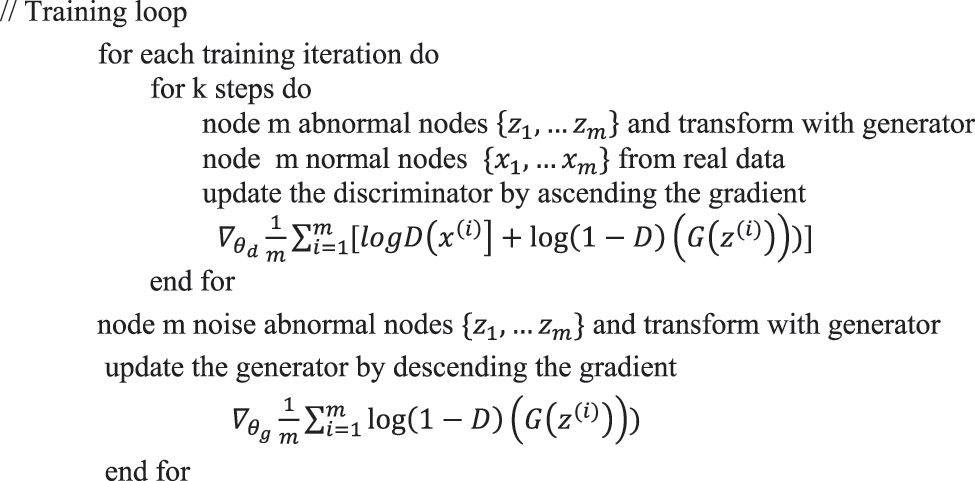
Figure 4: Pseudocode of training loop for elimination of attacker node
This formula derives from the cross-entropy between the real and generated distributions. The generator can’t affect the log(D(x)) term in the function, so, for the generator, minimizing the loss is equivalent to minimizing log(1−D(G(z))). The GAN loss function indicates that the generator tries to minimize the following function while the discriminator maximizes it.
Assume the transmission of data and jamming attack detection is executed in the wireless sensor network. The proposed approach working mechanism is as follows:
The cognitive radios [20,21] are deployed using uniform distribution in the network. Hierarchical communication is established between the sensor devices and the centralized base station. Each node updates its neighbor node [22,23] present in the coverage area using beacon/hello messages. Once the deployment and the neighbor communication are established data sensing and transmission are initiated. The path discovery process is involved to identify the available path between sensor and base station. The working progress of GDNN is shown in Fig. 5.
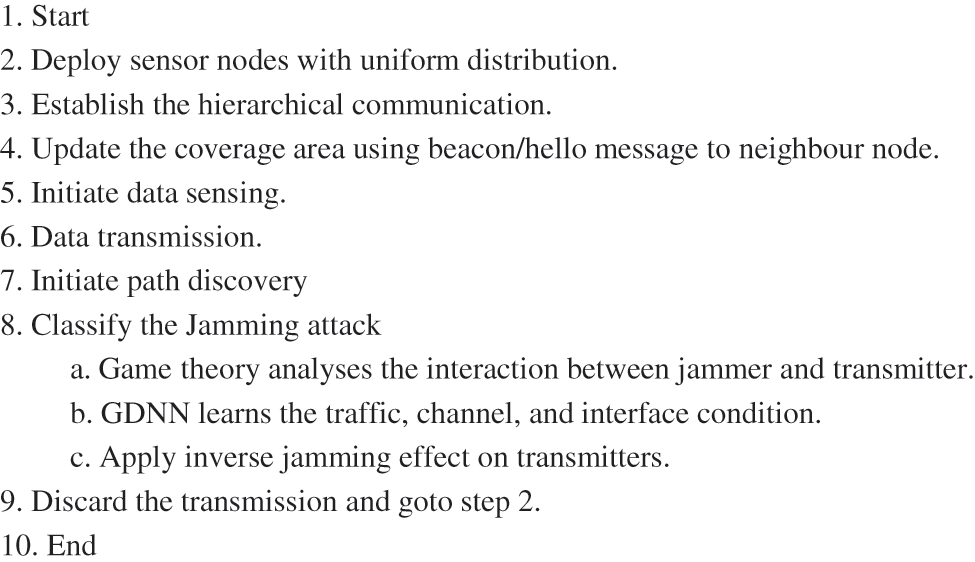
Figure 5: Pseudocode of GDNN–game theory
Jamming is performed by the attacker by generating more signal interference in the communication region to decrease successful transmission. The jammer applies an exploratory attack and studies the transmitter features of prior jamming. Under this attack, the jammer develops a classifier that represents a target classifier under attack. In a jammer, the transmissions or idle channels that tend to fail are not classified; instead, the jammer predicts the successful transmission, and jams it. The jamming of successful transmissions has two main objectives: (1) reducing the likelihood of misdetection and (2) reducing the likelihood of false alarms. Here, the transmit power is adjusted reference to the average power constraint. The selection of transmission power acts as a function of classification score at a time instant that tends to measure the probability of jamming attack as shown in Fig. 6. The malicious node detection is performed by invoking the GDNN game theory process.
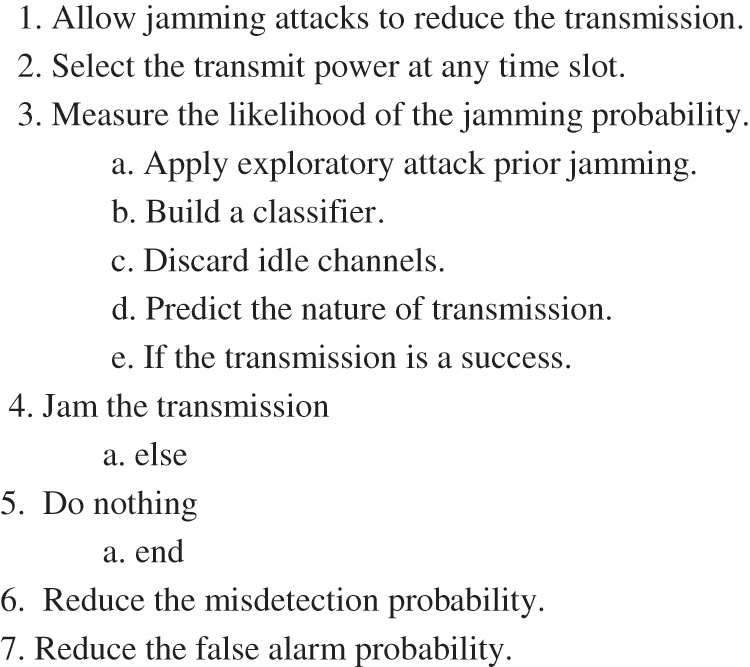
Figure 6: Pseudocode of jamming attack profile
4 Jammer Detection Using GDNN with Game Theory
Game theory in [24,25] general analyzes the conflicting communication between cognitive source transmitters and the jammers. During the transmission process GDNN learns the traffic condition, and interference in the channel that leads to success of data transmission between the radios. It further develops an inverse jamming strategy that increases the performance of communication [26,27]. The following input data for the neural network is collected at the time of data transmission after the data collection, and it includes the following:
• Packet forwarding count.
• Packet sent count.
• Drop counts of the data forwarder.
• Received signal strength (RSS) of each incoming data flow and its variations.
• Packet drop speed.
• Behavioral variations in radio and it is identified as:
• Average packet per flow count.
• Bytes per flow count and
• Rate of Flow Entries.
From the collected data, the generator tends to generate the synthetic data with real-time samples in a short duration. From the estimated parameters, the Gaussian Kernel function and the linear polynomial kernel function values are calculated to differentiate the legitimate nodes from the attacker nodes in the network. The consumption is also derived with the Eigen function for each parameter. The Gaussian Kernel function is illustrated as follows,
where n–number of sample,
The corresponding eigen function is defined as:
The polynomial kernel between the two parameters is computed as follows,
d-Indicates the degree.
The cumulative sum of the weighted input is computed as a trained value for each set of collected data that represents the node behaviors. The mean value of the training value is computed from the entire set of trained values, and it is represented as the predictor. The behavioral pattern formation for each parameter is computed by taking the individual parameter as input. The neural training is conducted with the cross-entropy loss function with back-propagation using the following Eq. (4)
where, θ–neural network parameters,
In hidden layer, sigmoid and hyperbolic tangent (Tanh) functions are used for the activation and it is defined as Eq. (5)
where (z)–sigmoid function, Tanh is the hyberbolic tangent function, z–input, k-entry count.
The output layer is activated using the softmax activation function with the gradient descent and it is denoted in the Eq. (6)
4.2 Game Theory Formalization on GAN
Once the output value is activated the minimax game is invoked between the generator and discriminator. The game strategy is illustrated in the Eq. (7)
where z-input error,
Upon completion of the minimax game, the activated output represents the behavioral difference between the normal and attacker node. This will classify the attacker node and eliminate it from the data communication.
This section evaluates the efficacy of jamming attack detection and model using GDNN-game theory under different network conditions. The running environment is setup with the following parameters as in Tab. 1. The proposed method is tested in terms of various network metrics that includes energy consumption, residual energy, packet delivery ratio, NRO, delay (ms), throughput, jitter, goodput, packets dropped, relative energy, and network lifetime. The proposed method is compared with existing methods in terms of simulation time and packet generation interval to test how well the systems respond to the jamming attacks at the transmitter. The proposed GDNN-game theory (short GDNN) is compared with other existing methods that include mitigating stealthy jamming attacks (MJSA) and stealthy data transmission with deep learning (SDTDL) [28].

According to the simulation, game adversarial network (GAN) is used to learn about the transmission properties, as well as predict the possibility of attacks at an early stage; the system has higher success rates and improved network characteristics. A GDNN-game detection model is evaluated under different network conditions in this section to determine its effect and compare it to other methods.
It refers to the total energy available of all nodes in the network after completing the data transmission, and it is computed by subtracting the consumed energy from the initial energy as shown in Figs. 9 and 24.
It refers to the total consumed energy of all nodes in the network after computing the data transmission, and it is computed as shown in Figs. 7 and 22.
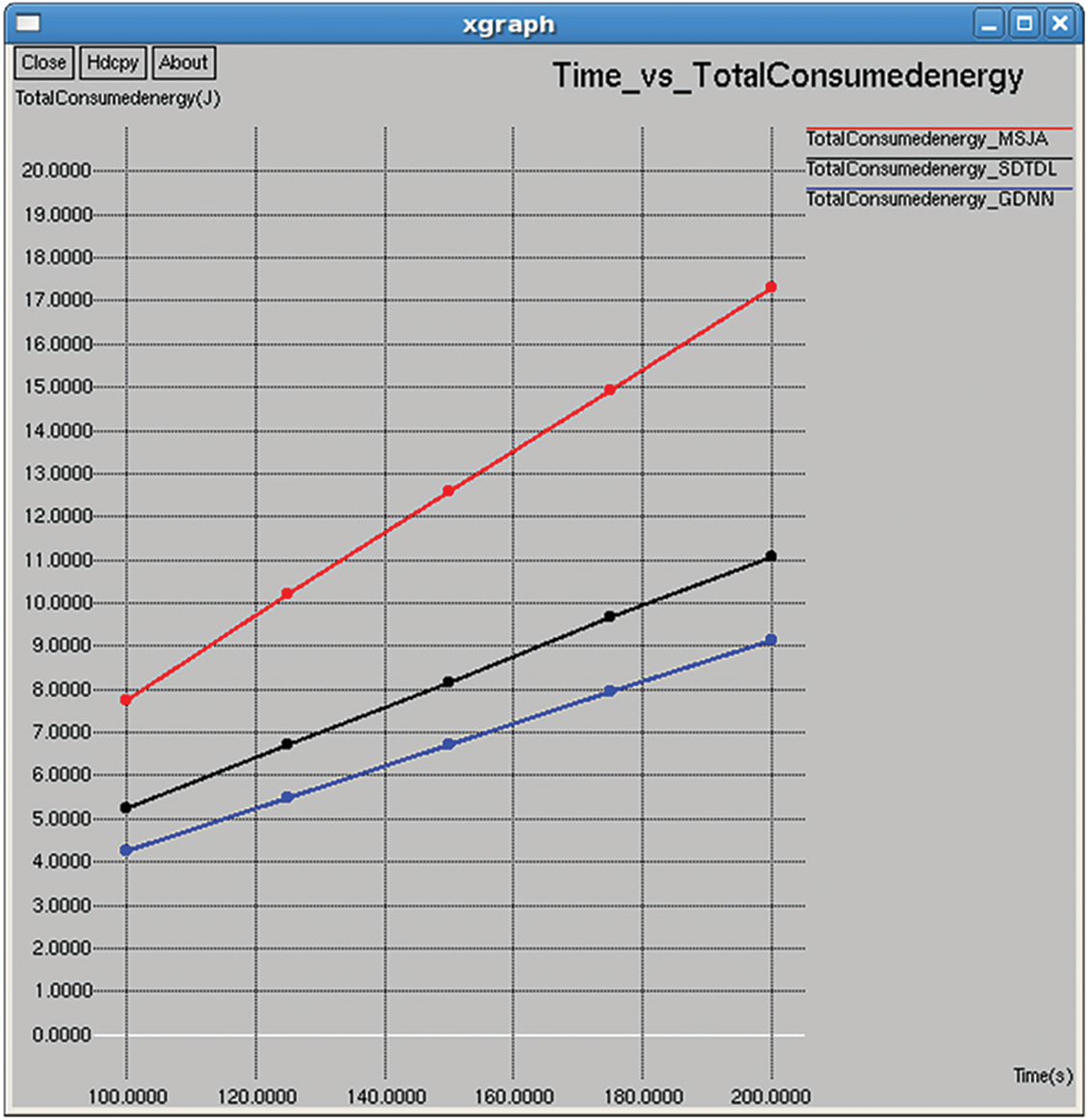
Figure 7: Total consumed energy
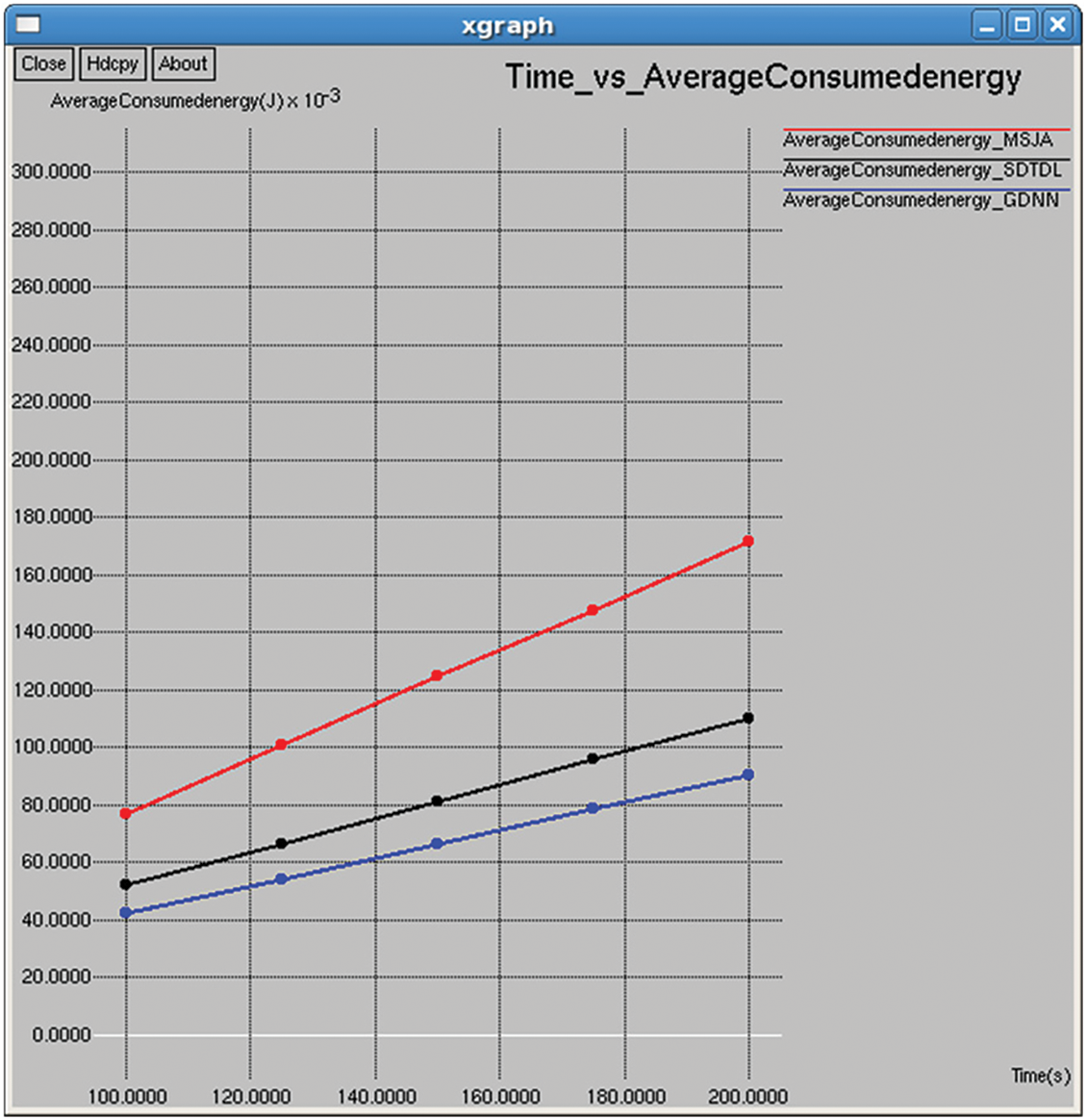
Figure 8: Average consumed energy
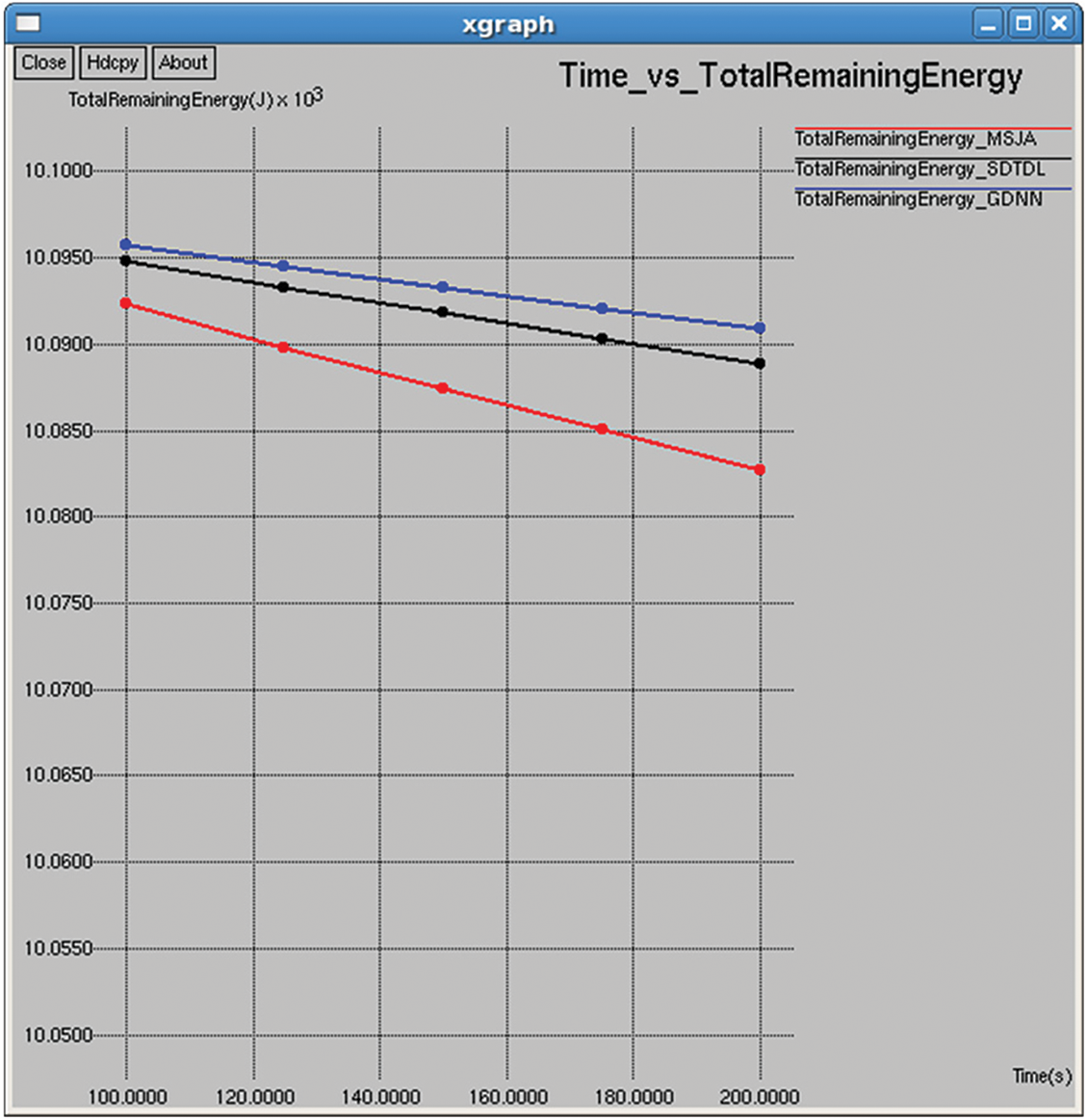
Figure 9: Total remaining energy
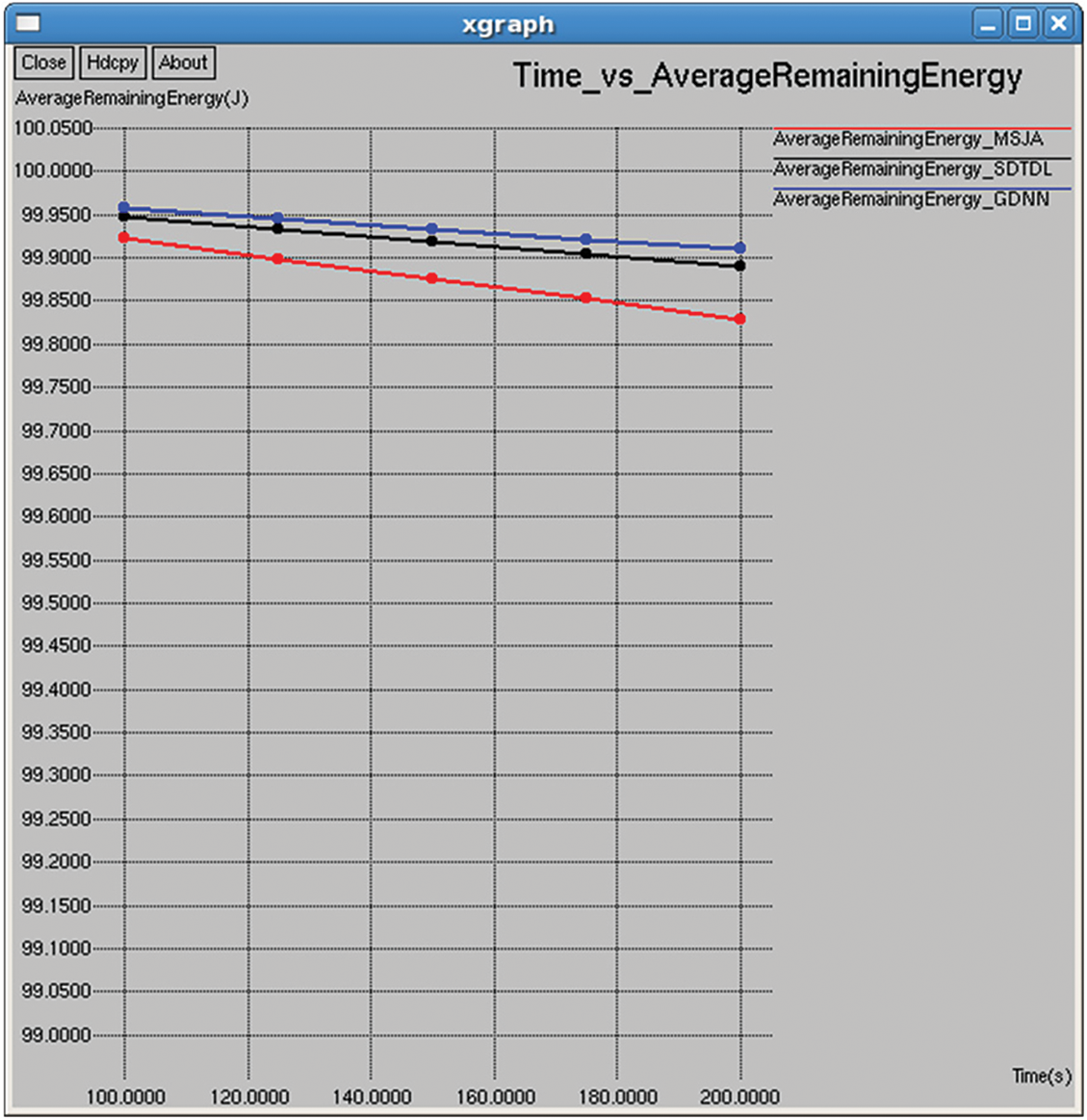
Figure 10: Average remaining energy
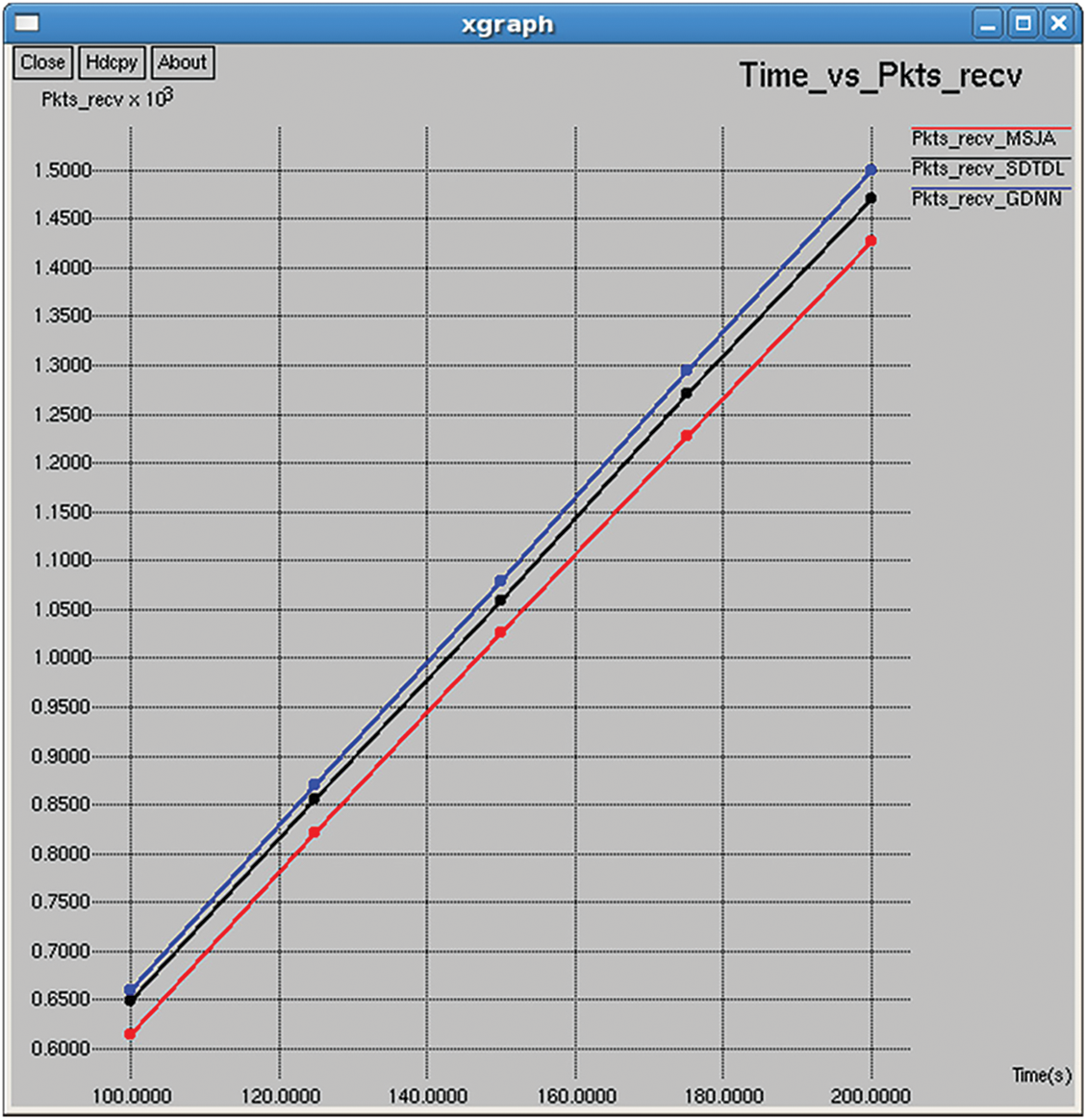
Figure 11: Total packets received
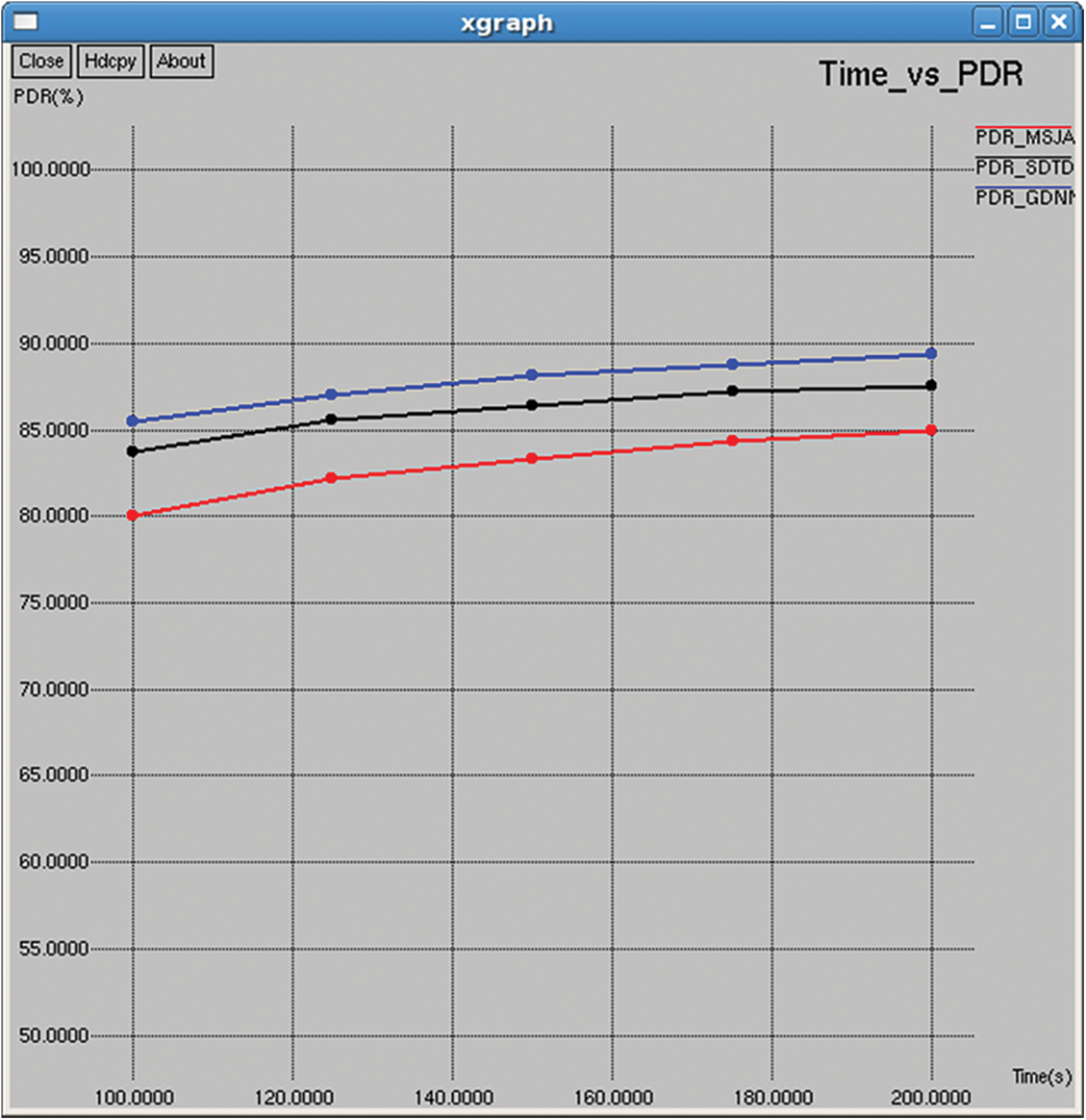
Figure 12: Packet delivery ratio

Figure 13: NRO
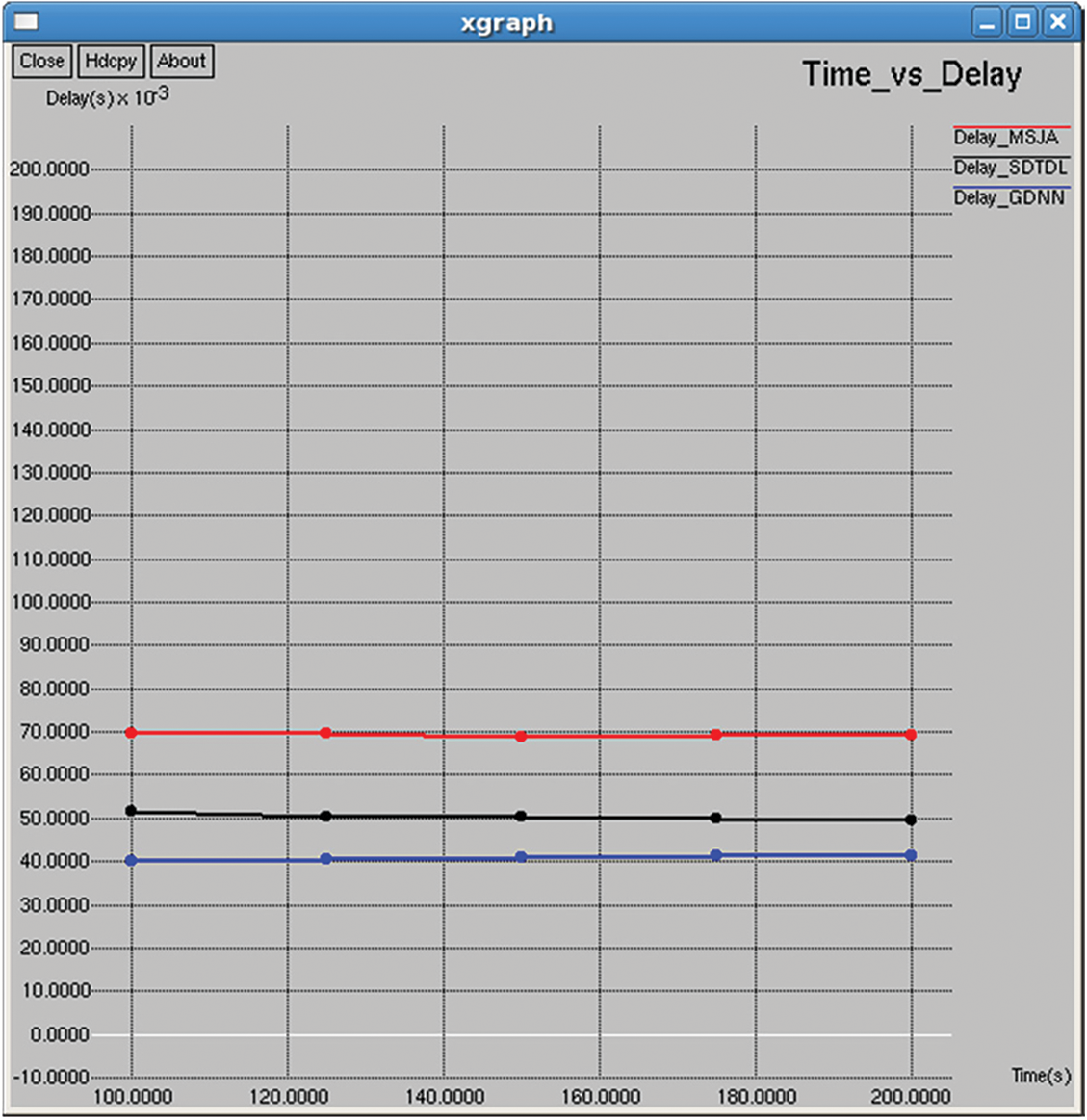
Figure 14: Delay (ms)
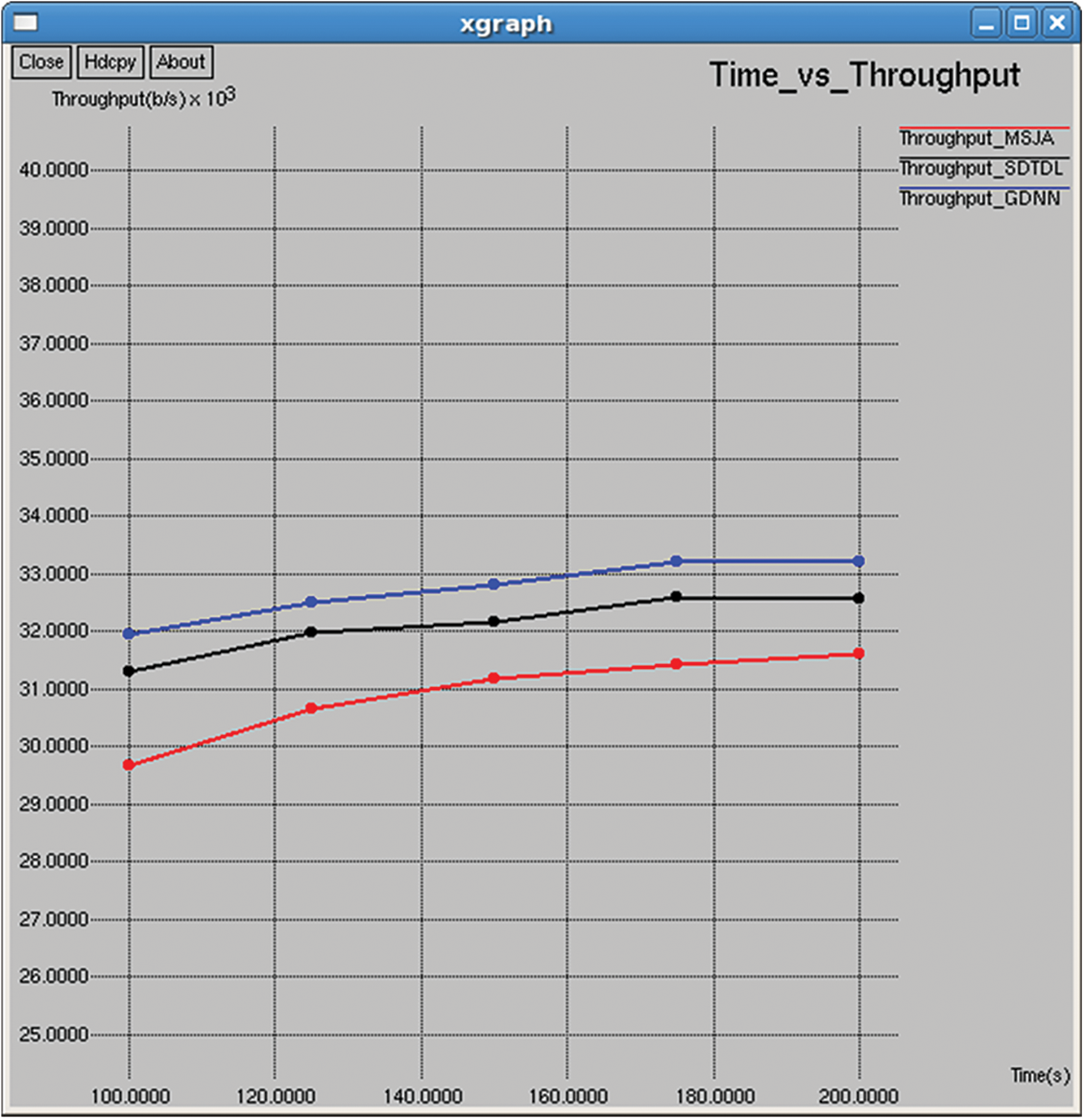
Figure 15: Network throughput
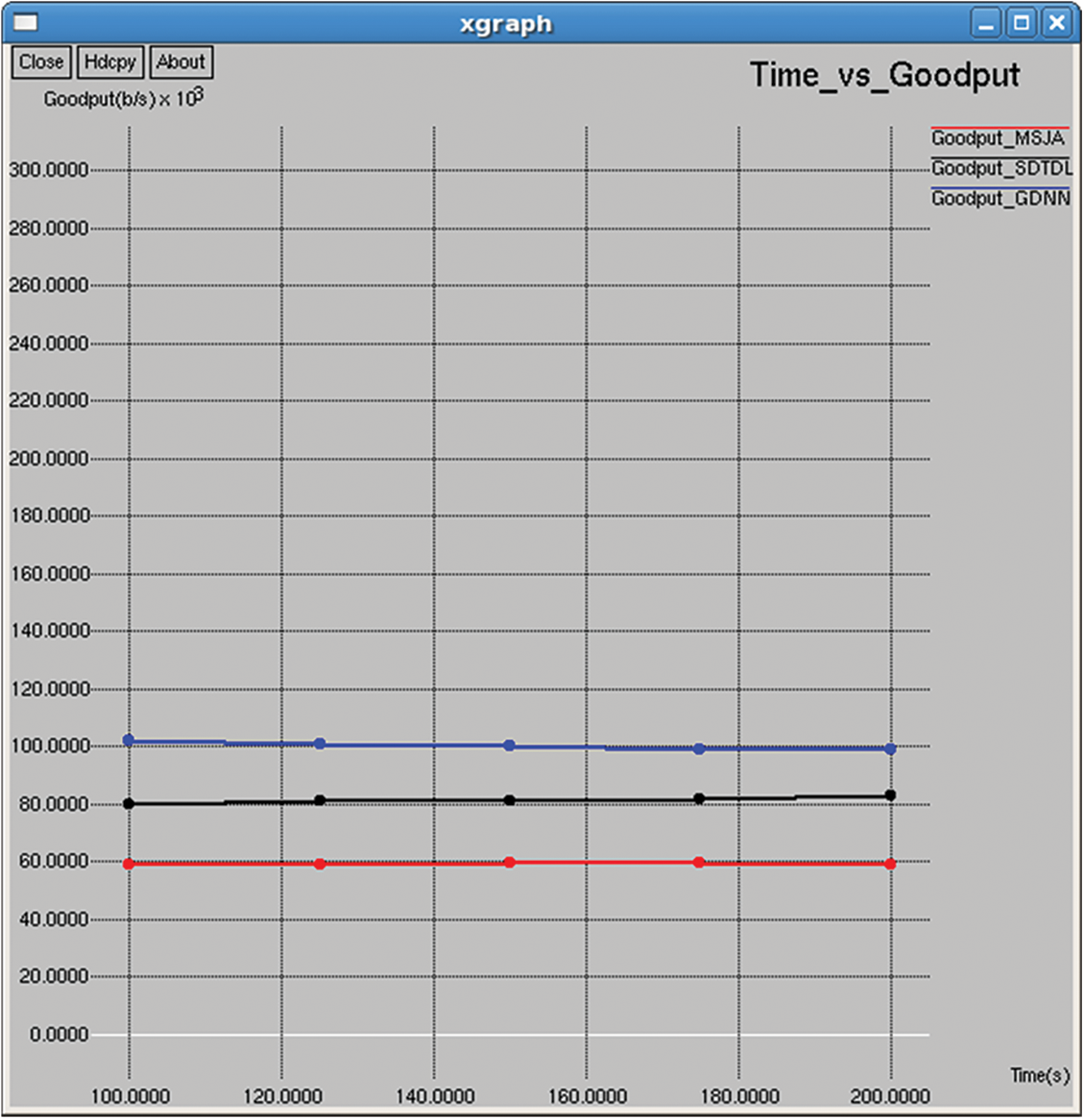
Figure 16: Goodput
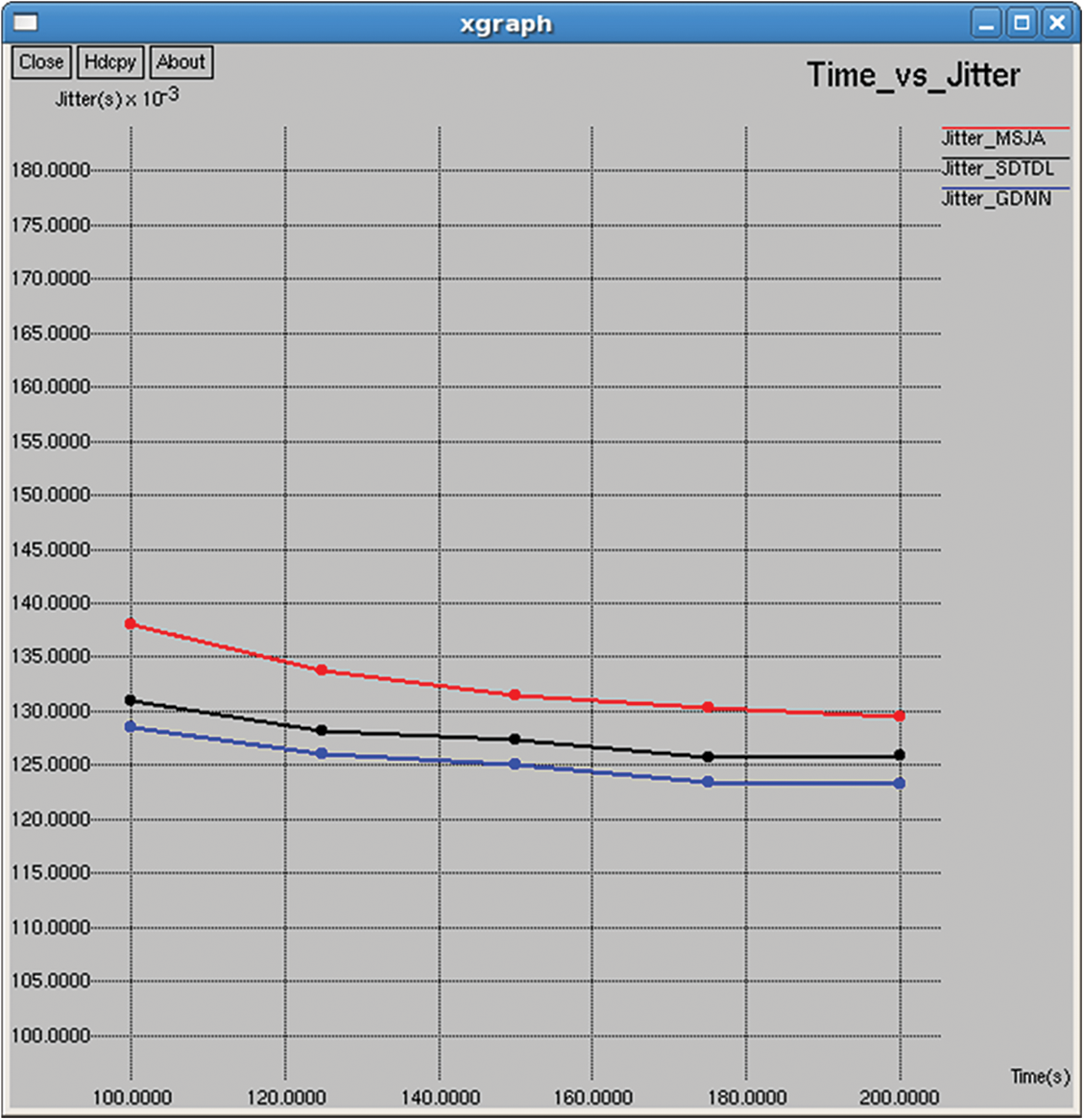
Figure 17: Jitter

Figure 18: Packets dropped
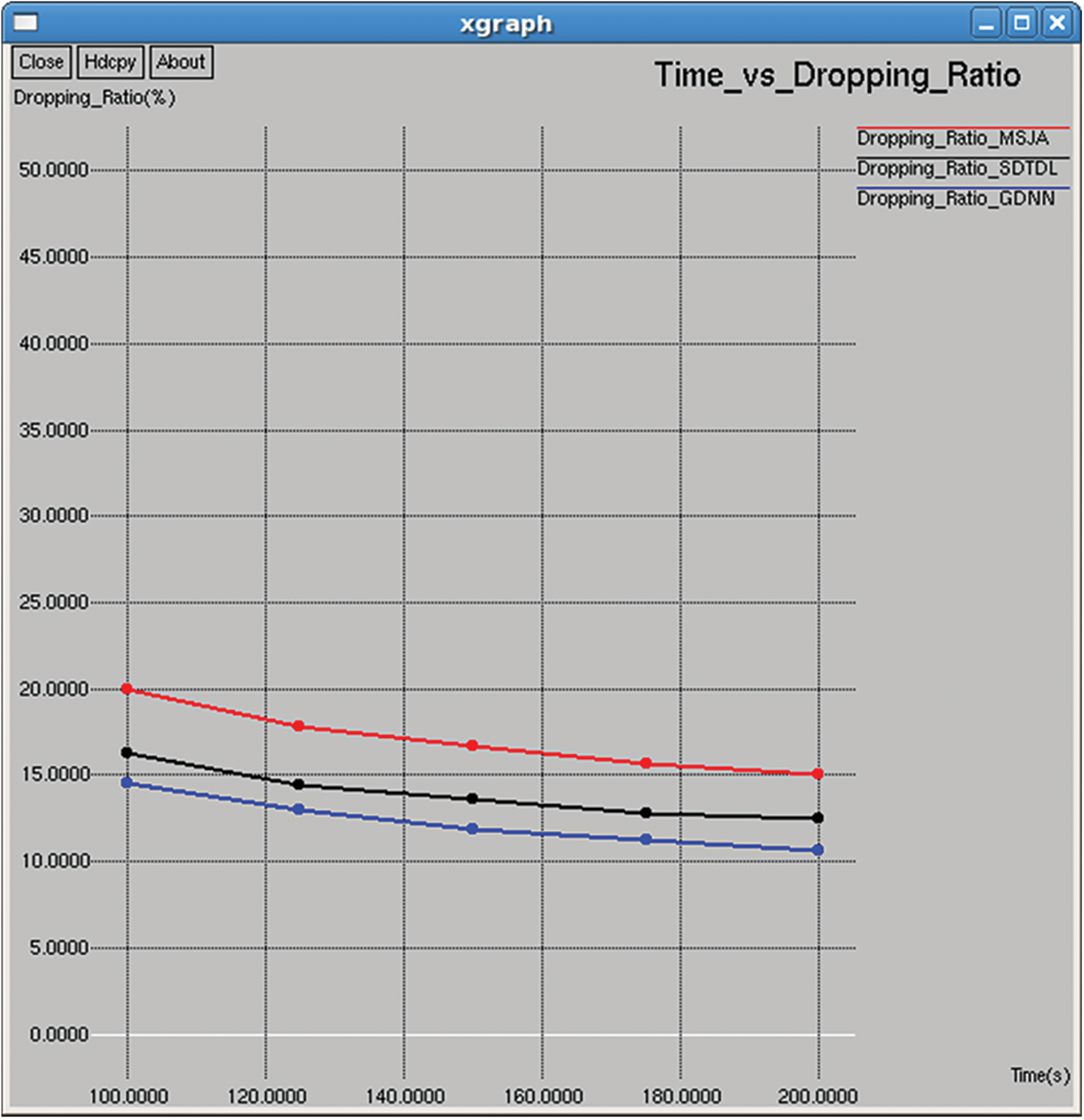
Figure 19: Dropping ratio

Figure 20: Relative energy
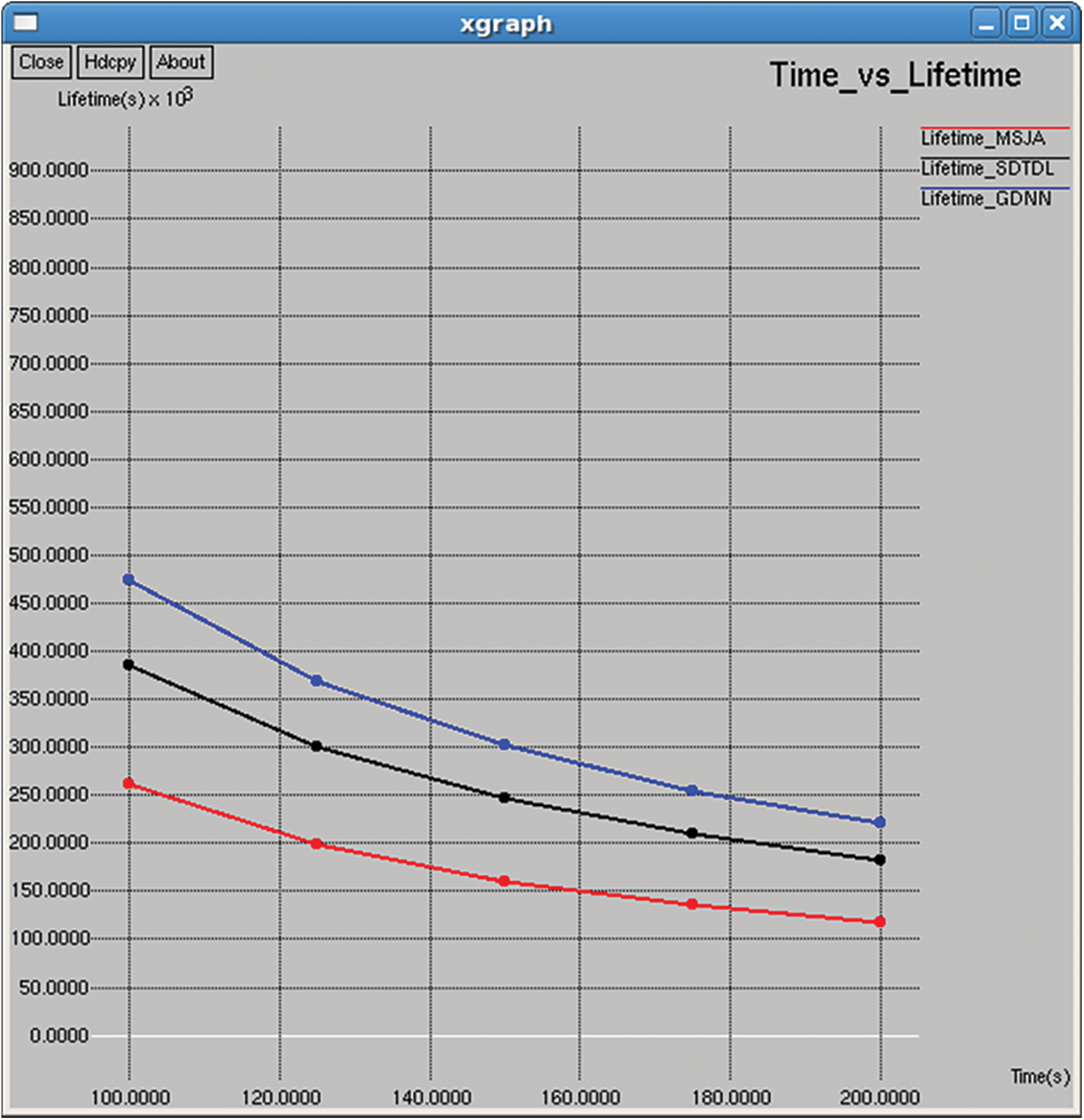
Figure 21: Life time
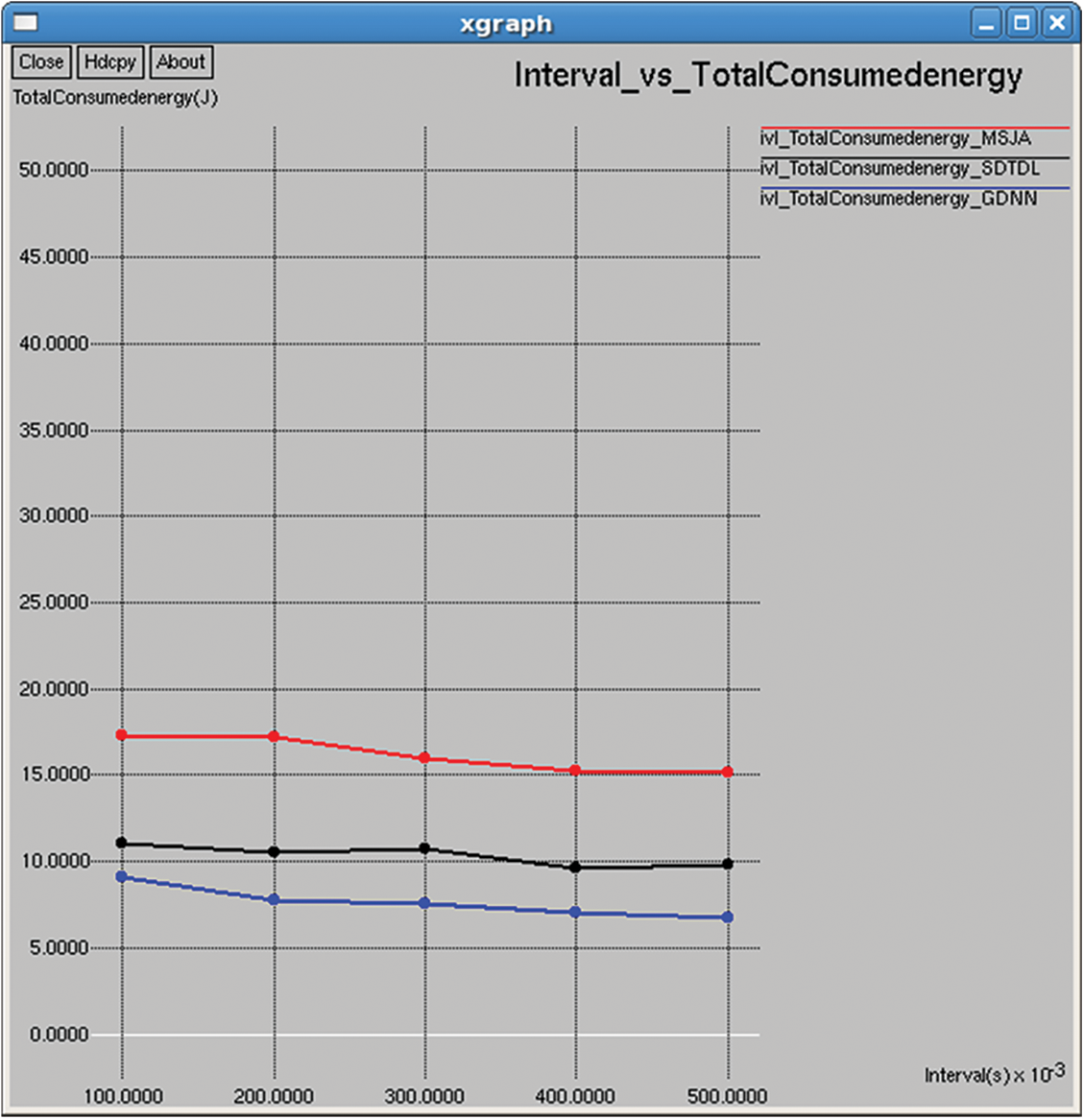
Figure 22: Total consumed energy
Its outcome is the number of bits transmitted per unit of time. It is calculated from the size of the data packet, and the total number of received data packets with the transmission duration, as shown in Figs. 15 and 30.
It refers to the average energy required to complete the unit data transmission, as shown in Figs. 20 and 35.
It indicates the total number of successful transmission completed in the network as shown in Figs. 11 and 26.
5.1.6 Number of Dropped Packets
Number of dropped packets: It is computed as the difference between the number of attempted packet transmissions and the number of successful packet transmission, as shown in Figs. 18 and 33.
5.1.7 Packets Distribution Ratio (PDR)
PDR is the ratio between the number of packets successfully received and number of packets attempted for transmission. It represents the success ratio of transmission over the wireless medium, as shown in Figs. 12 and 27.
5.1.8 Normalized Routing Overhead (NRO)
It represents the number of control messages required to transmit a single data packet, and it is calculated from the value of dividing the total number of received packets by the total number of control overhead messages, as shown in Figs. 13 and 28.
Time taken to drain the total energy of the nodes based on the transmission, and it is computed as shown in Figs. 21 and 36.
It refers to the average consecutive packet transmission delay as shown in Figs. 17 and 32.
It is the ratio of the total number of data bits transmitted for the entire simulation to the time taken to complete the overall transmission, as shown in Figs. 16 and 31.
It is the ratio between the number of failed packet transmissions and number of attempted packet transmission, as shown in Figs. 19 and 34.
It refers to the average time taken to complete the end-to-end transmission of data packets from source to destination in the network, as shown in Figs. 14 and 29.
5.1.14 Average Remaining Energy and Average Consumed Energy
It refers to the average energy available of all nodes in the network after completing the data transmission and it is computed by subtracting the consumed energy from the initial energy as shown in Figs. 10 and 25. Average consumed energy refers to the average consumed energy of all nodes in the network after completing the data transmission, and it is computed as shown in Figs. 8 and 23.
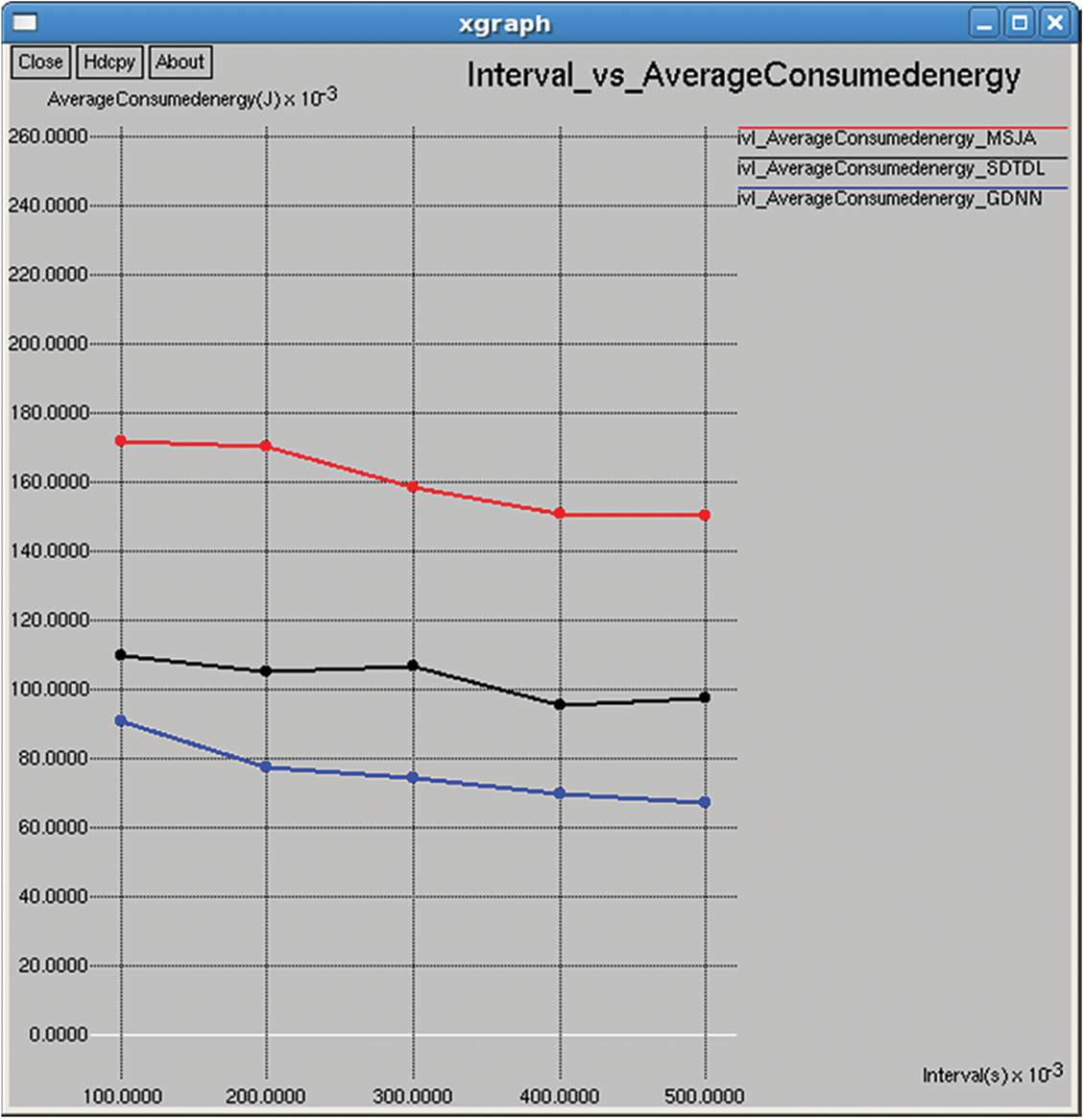
Figure 23: Average consumed energy
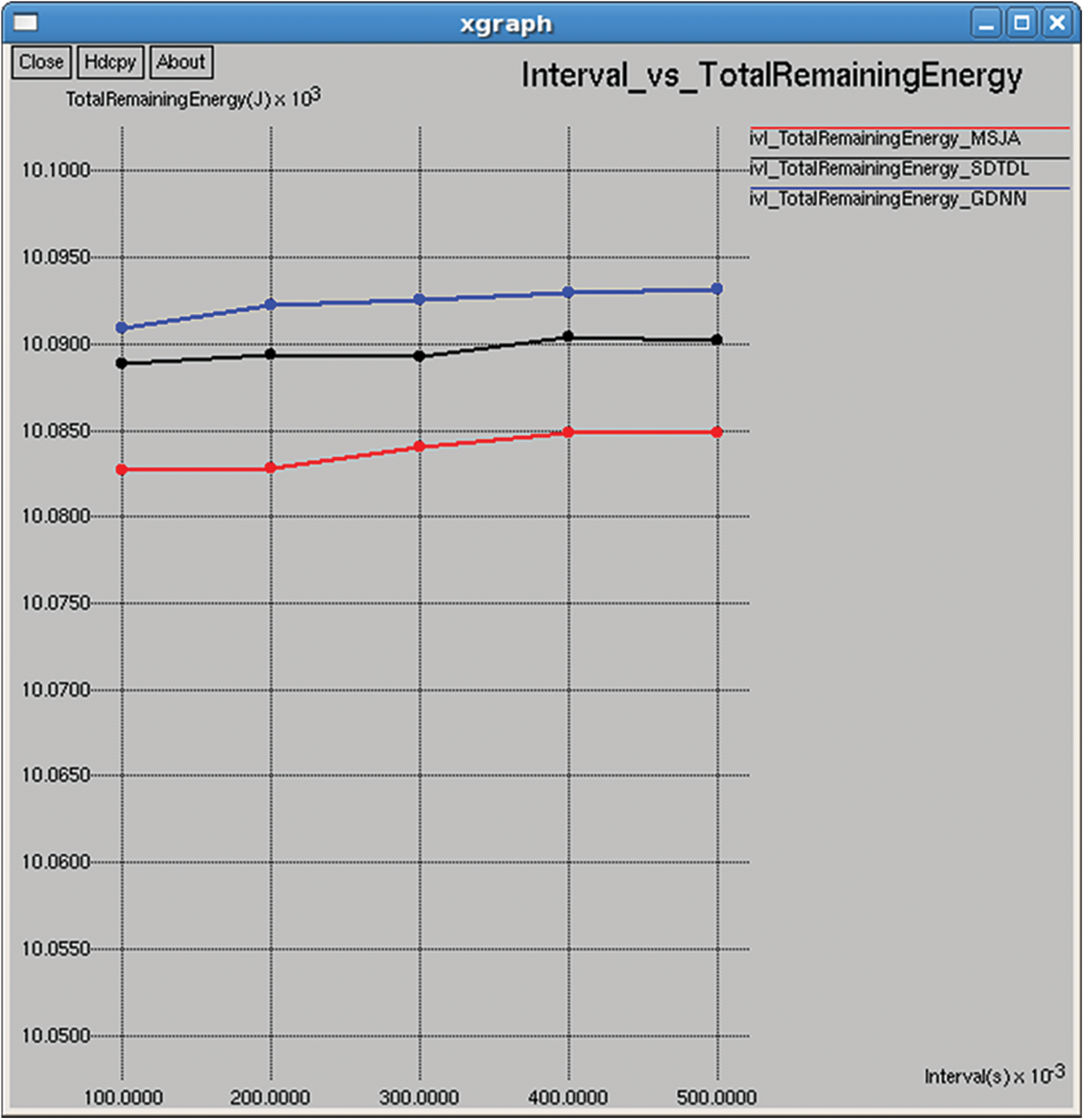
Figure 24: Total remaining energy
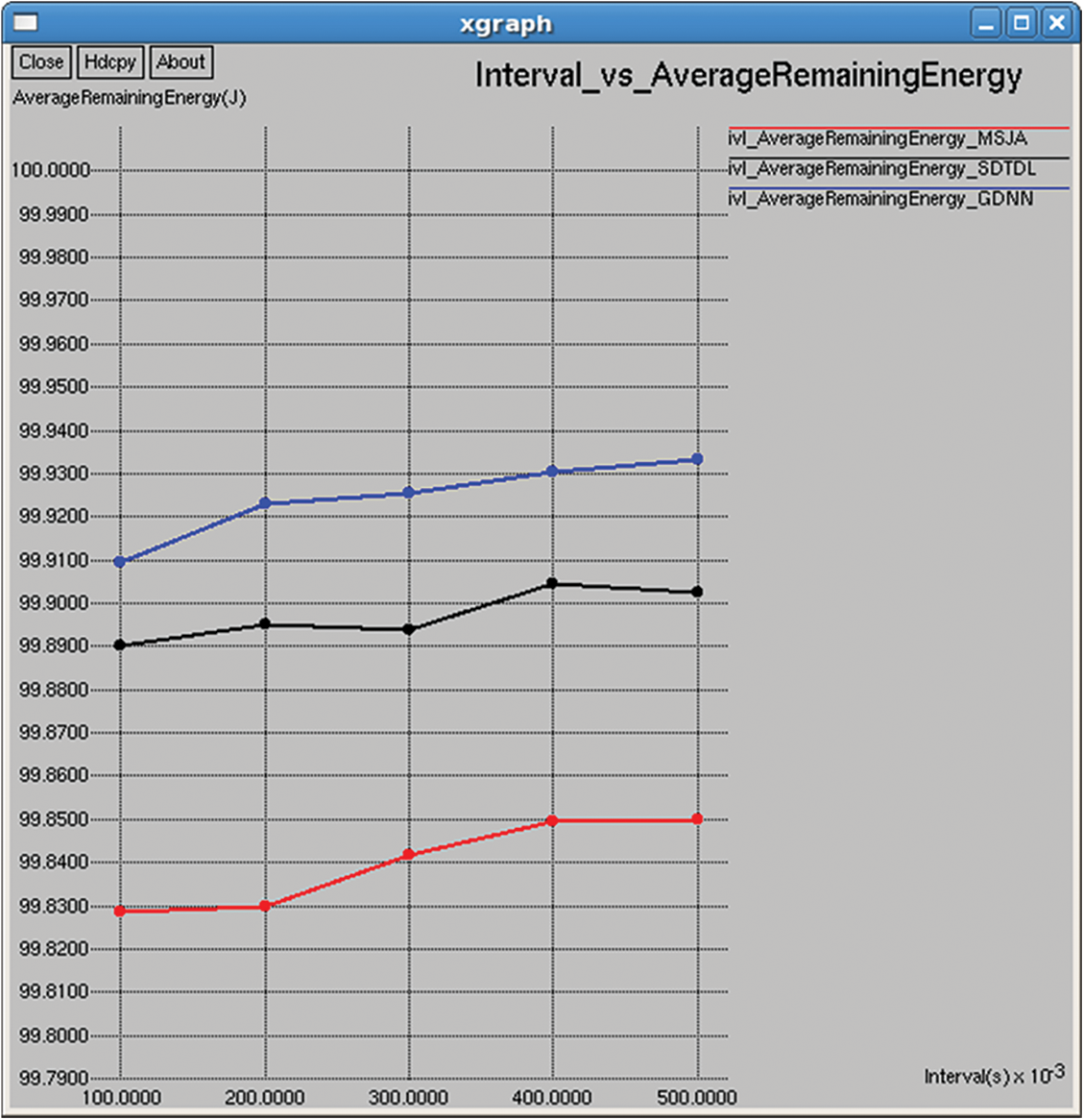
Figure 25: Average remaining energy
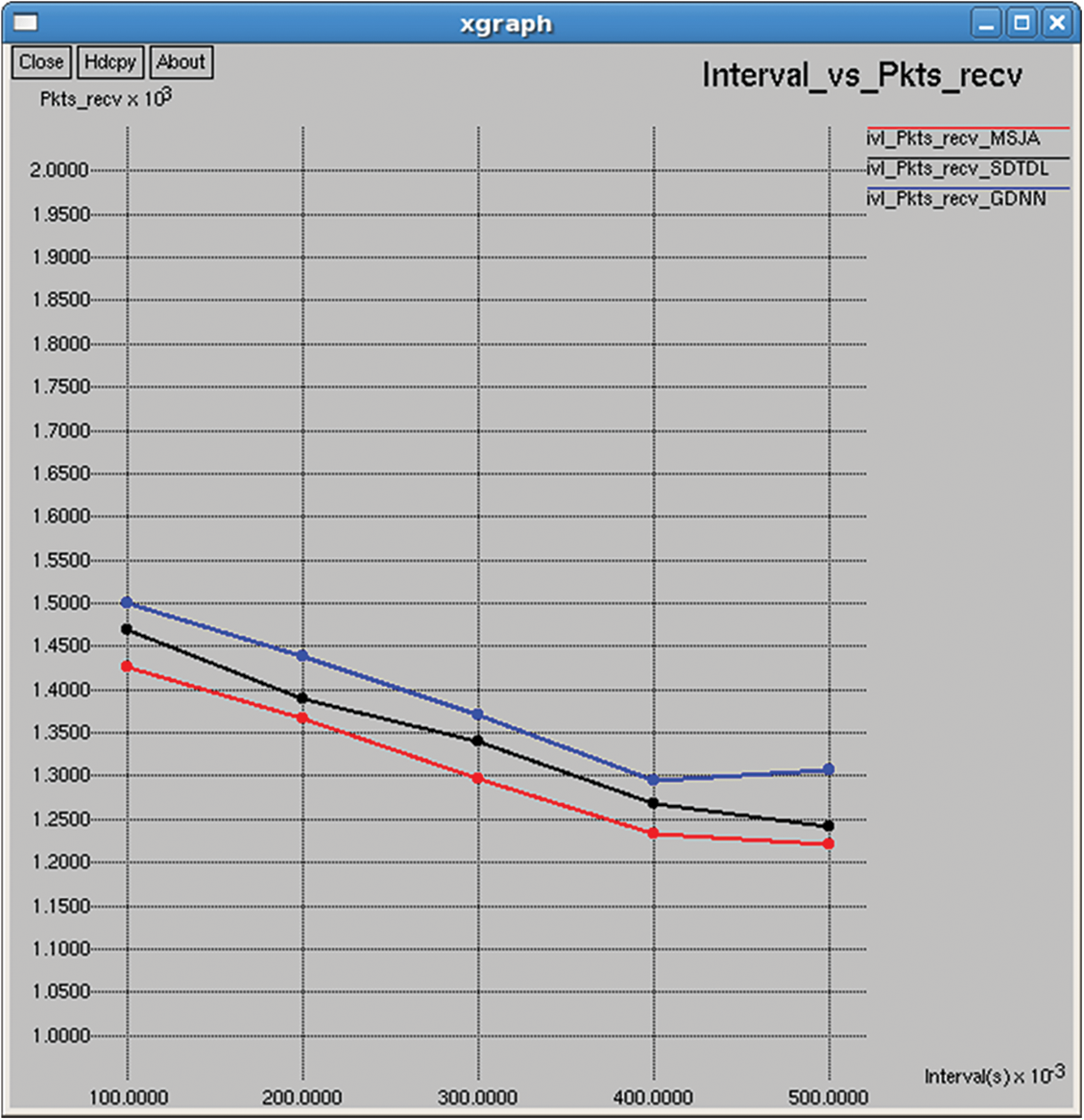
Figure 26: Total packets received
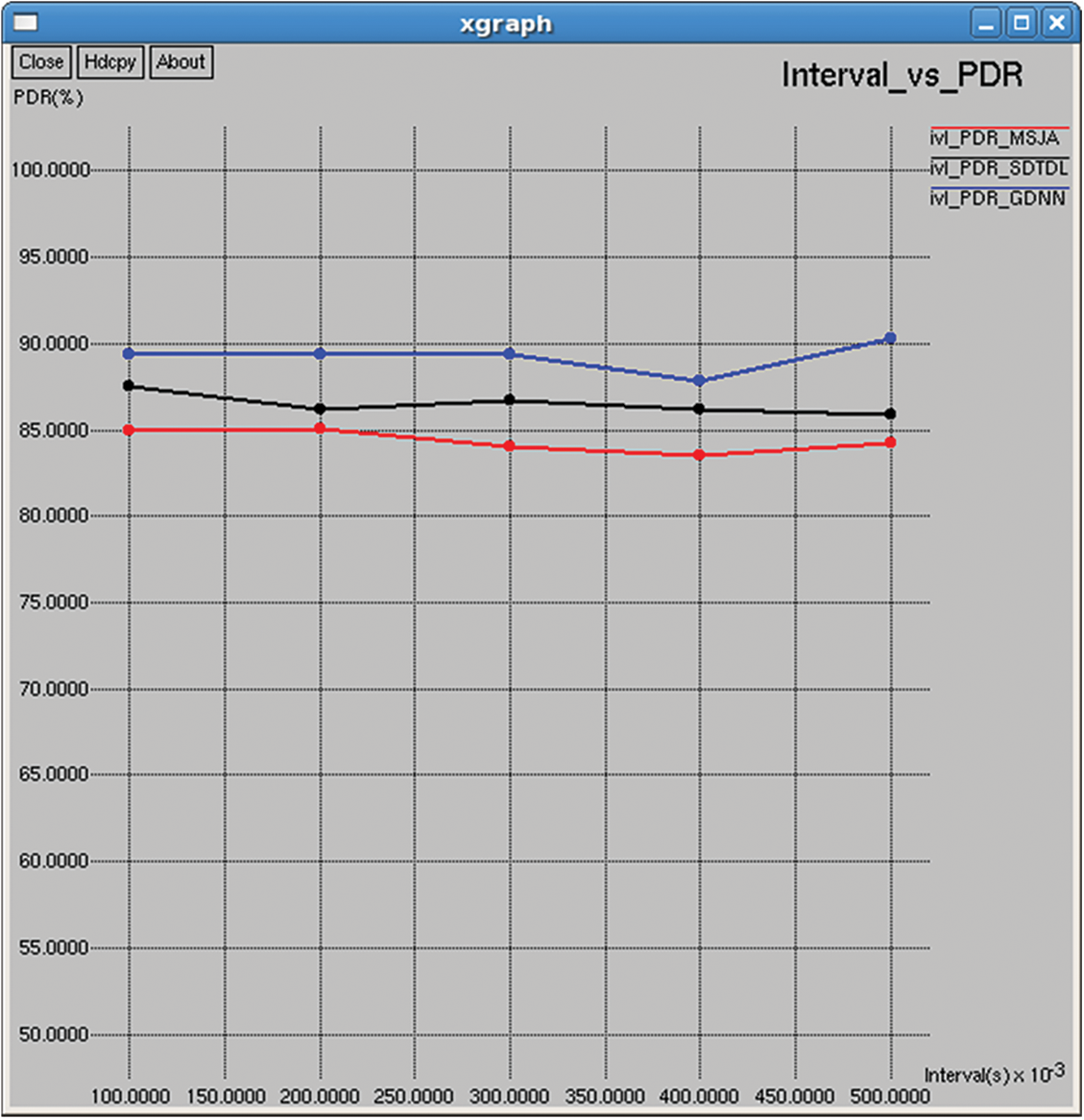
Figure 27: Packet delivery ratio

Figure 28: NRO

Figure 29: Delay (ms)

Figure 30: Network throughput
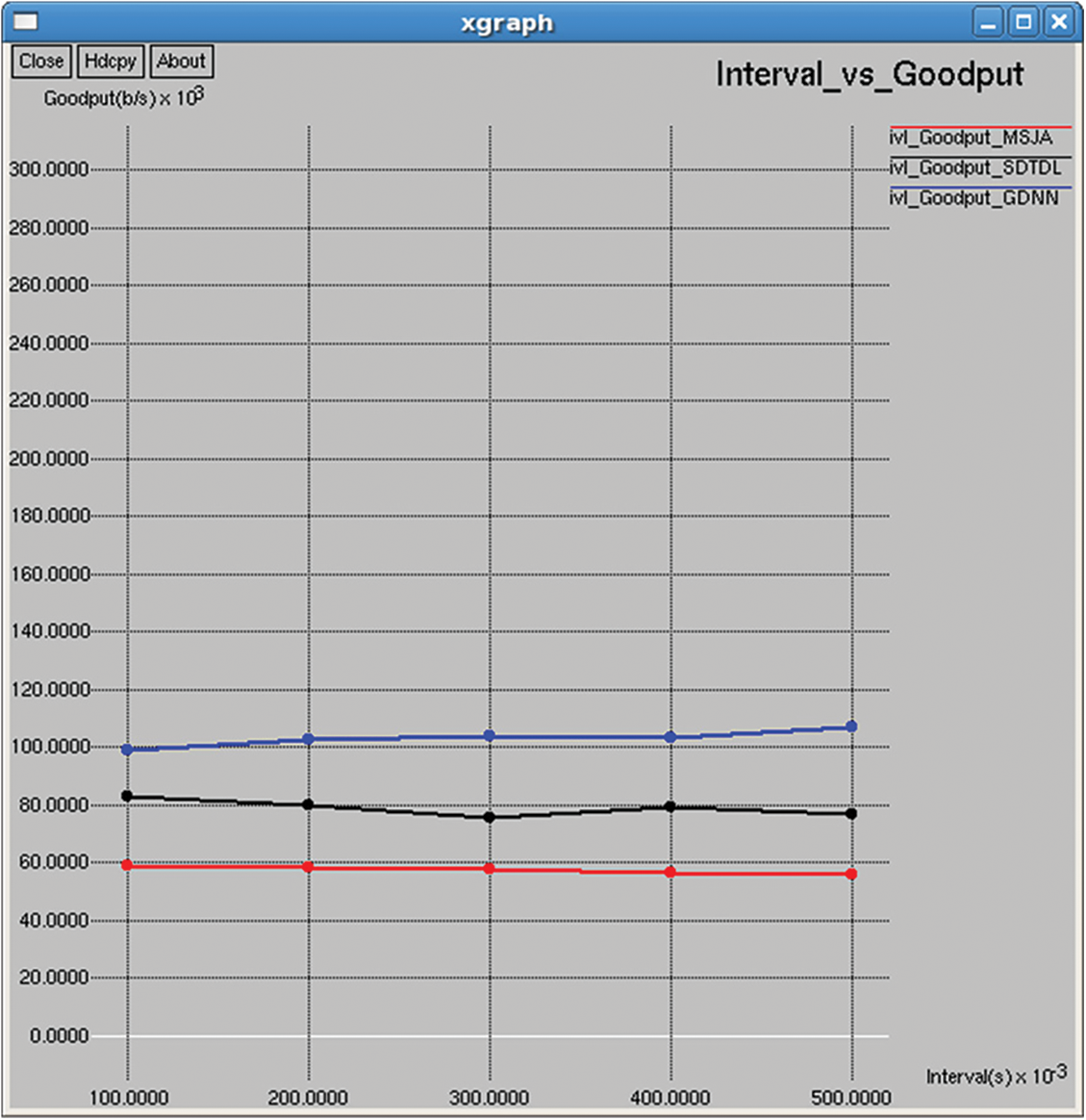
Figure 31: Goodput
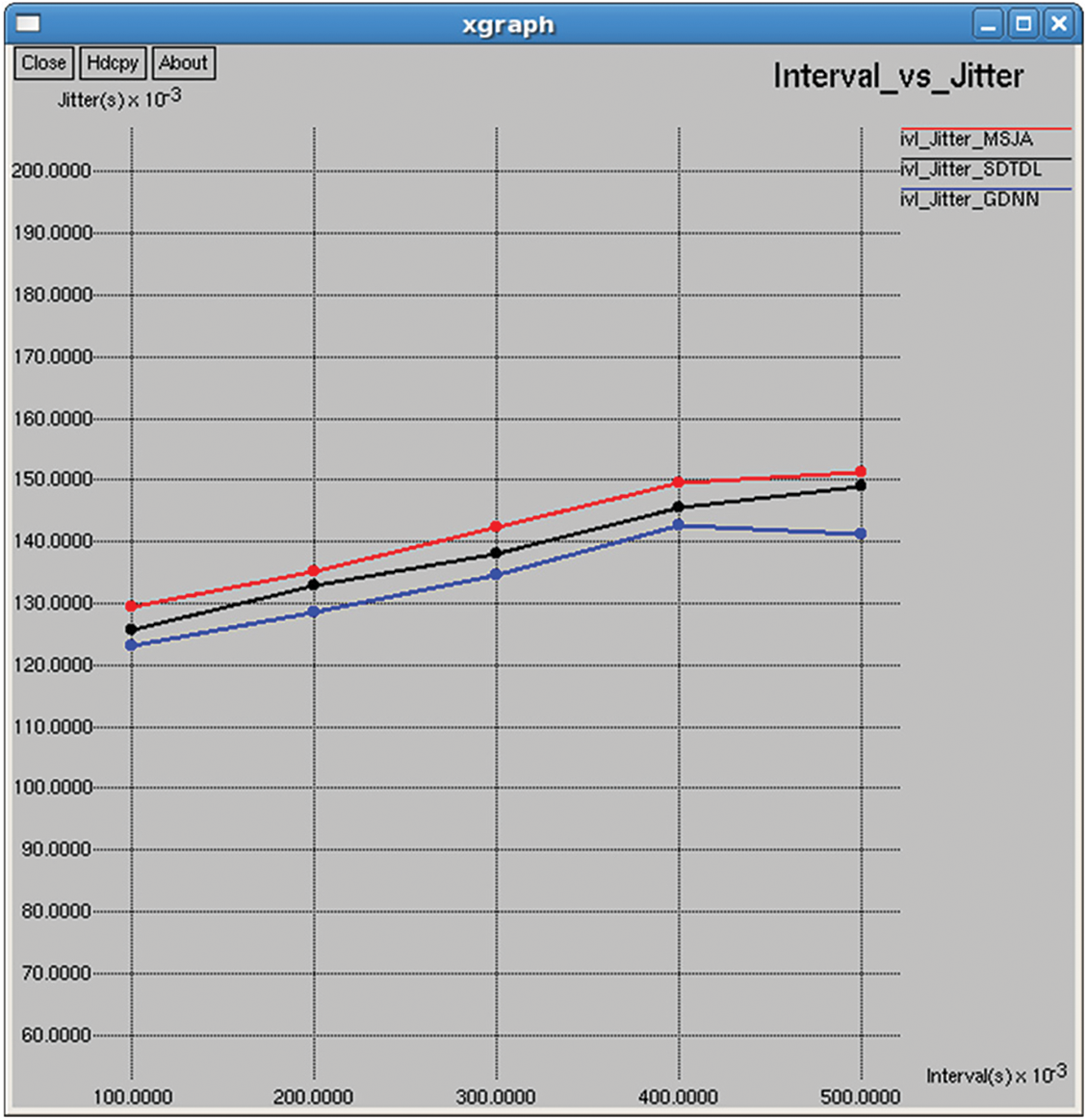
Figure 32: Jitter
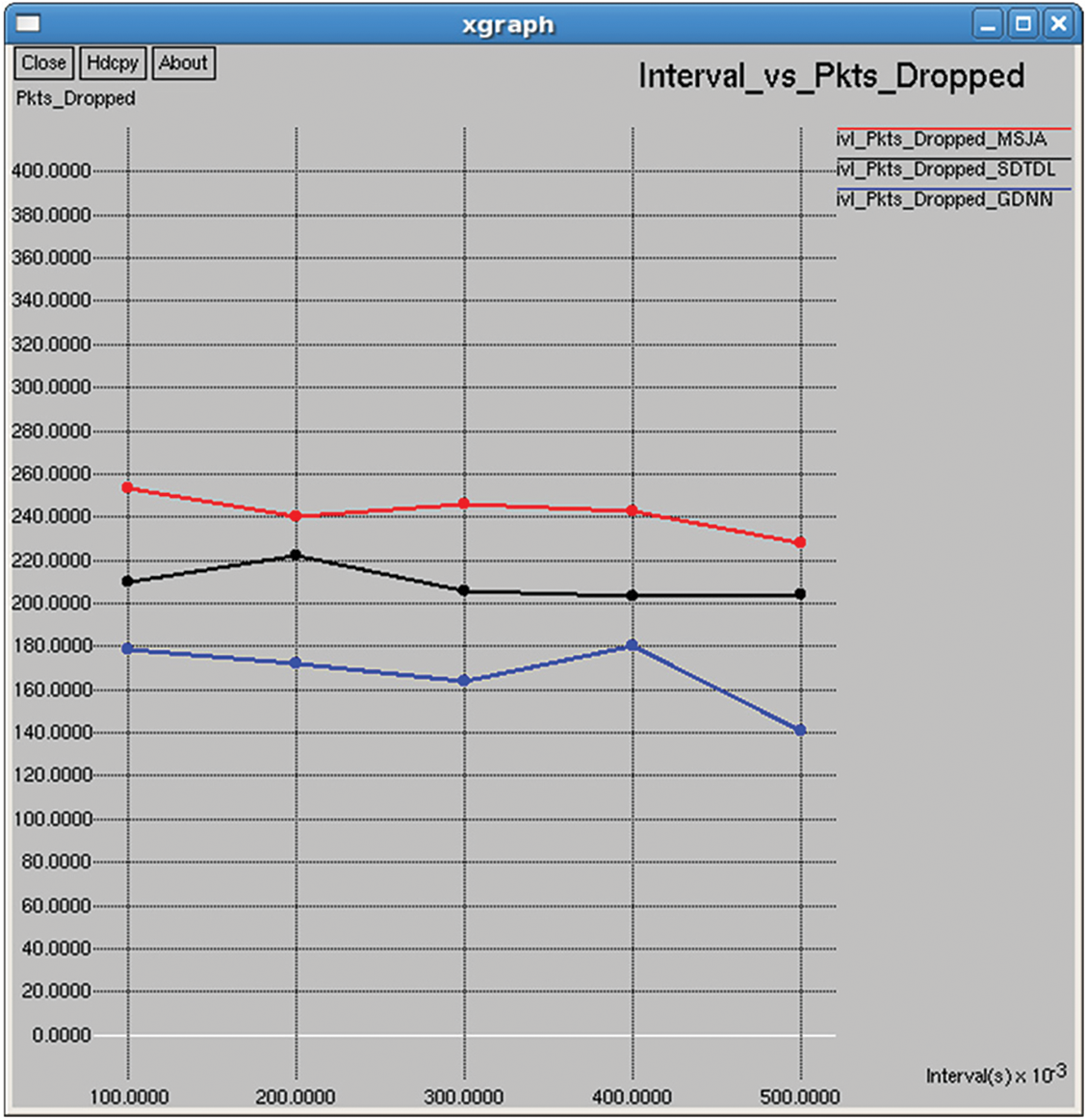
Figure 33: Packets dropped
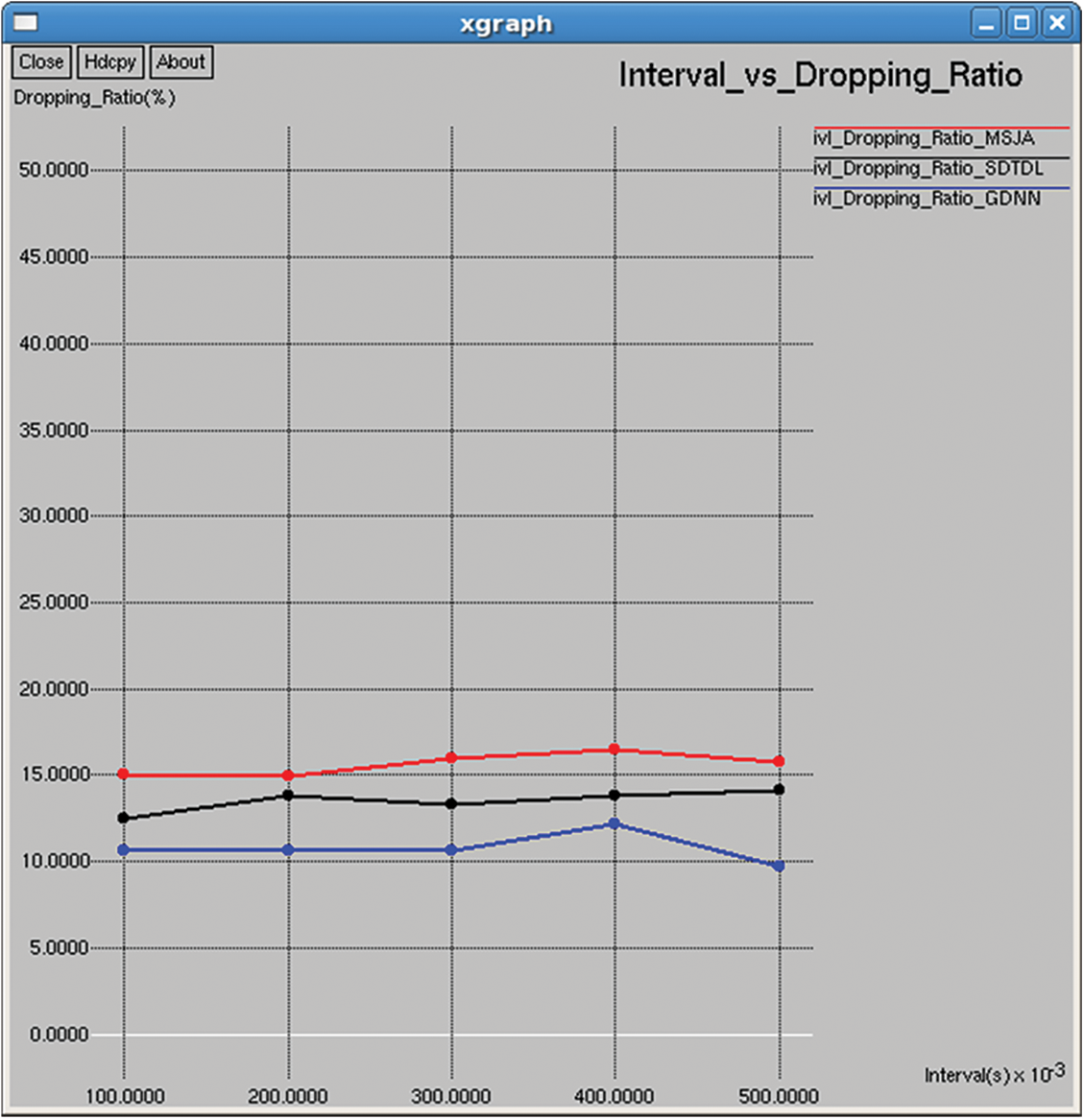
Figure 34: Dropping ratio

Figure 35: Relative energy

Figure 36: Lifetime
5.1.15 Attacker Detection Ratio and Detection Delay
It represents the total number of attackers detected from the attacker presents in the network. Detection delay refers to the average time taken to detect the node from the time of attacker launch, as shown in Tab. 2. Tabs. 3 and 4.



The proposed model includes components such as sensor nodes, base station, neural network and input and output layers. The results of a GDNN based jamming detection are presented in which parameters such as attacker detection ratio and detection delay metrics are compared with other method such as MSJA and SDTDL and the best result is presented as the recommended method, as shown in Tabs. 2–4.
The packet delivery ratio has improved, and the routing overhead has been minimized. On comparison with MSJA and SDTDL it improves the lifetime of the network. Metrics jitter measures the delay between packets. It must be possible to transmit without any hindrance if the delay between transmission is negligible.
The disseminated learning network is used to find deviations in the behavior of nodes. This leads to a reduction in jitter and packet loss, as well as an increase in throughput.
The trained deep neural network validates the characteristics of each node. The neural network output is the nodes status. The node is removed from data transmission if it is determined to be malicious.
In order to initiate the data transmission, the route from the source node to the destination must be determined. The routes have to be identified and sensed. The data transmission is initiated after the route has been identified. An attacker node is detected and removed from the network during the transmission of data. For evaluating the performance of suggested methodology, certain metrics such as jitter, goodput, throughput, packet dropped, packet delivery ratio are proposed.
Good performance contributes to the amount of information delivered and the packet dropping ratio must be low. This result of metrics shows that the GDNN is capable of successful transmission of the metrics.
Here we will present graphical representations of the comparison of various metrics with time, as well as compare various metrics with packet generation intervals.
5.2 Comparison of Various Metrics w.r.t Time
In this section, we present the simulation results on various performance metrics between the GDNN and existing methods. The results show reduced total, and average consumed energy, reduced total and average residual energy, increased packets received with packet delivery ratio reduced packets dropped with reduced packet dropping ratio, reduced delay and jitter, and increased goodput and network lifetime than existing methods. Further, it is seen that the utilization of the attack detection model using GDNN enables optimal transmission of data packets successfully between the source and base station (BS). However, the case is not true in existing methods, the entire computational efficiency is spent on detecting the attack model rather than successfully sending the packets to BS from the source transmitter.
5.3 Comparison of Various Metrics w.r.t Packet Generation Interval
This section provides the results of various performance metrics evaluated between the proposed and existing methods in terms of packet generation interval. The simulation results are similar to those that appeared w.r.t to the training interval. However, it is seen that the total and average consumed energy reduced with increasing packet generation interval (PGI) are against the simulation time, where consumption increases with time. The same is the case of the total packets received, network throughput and packets dropped. On other hands, it is seen that with increasing PGI, the following parameters increases total and average residual time, packet delivery rate, NRO delay, jitter, etc., against simulation time, where it acts in reverse manner.
From the simulation, it is inferred that the utilization of GAN is used to learn the transmission properties and predict the possibility of attacks at the earliest manner and ensures that the system obtains increased network characteristics with a higher successful transmission rate than other methods.
In this paper, we model a GDNN to improve the success of the transmission rate between source and BS by mitigating jamming attacks. GDNN with generator and discriminator type neural networks with the minimax game theory automatically adapts to the spectrum dynamics. The training of GDNN with such a defense mechanism misleads the jammers to attack the transmission of data. Such misleading via game theory does not allow the jammers to select the time slot since it makes inaccurate predictions on classification sources. Such poor decisions by jammers prevent major transmission losses and make the model efficient in successfully transmitting data packets between the source and destination nodes.
Funding Statement: The authors received no specific funding for this study.
Conflicts of Interest: The authors declare that they have no conflicts of interest to report regarding the present study.
References
1. X. R. Zhang, W. Z. Zhang, W. Sun, H. L. Wu, A. G. Song et al., “A real-time cutting model based on finite element order reduction,” Computer Systems Science and Engineering, vol. 43, no. 1, pp. 1–55, 2022. [Google Scholar]
2. Y. E. Sagduyu, R. A. Berry and A. Ephremides, “Jamming games for power controlled medium access with dynamic traffic,” in Proc. ISIT, Austin,Texas, USA, pp. 1818–1822, 2010. [Google Scholar]
3. W. Sun, G. C. Zhang, X. R. Zhang, X. Zhang and N. N. Ge, “Fine-grained vehicle type classification using lightweight convolutional neural network with feature optimization and joint learning,” Multimedia Tools and Applications, vol. 80, no. 20, pp. 30803–30816, 2021. [Google Scholar]
4. Y. E. Sagduyu, R. A. Berry and A. Ephremidesi, “Wireless jamming attacks under dynamic traffic uncertainty,” in Proc. 8th Int. Symp. on Modeling and Optimization in Mobile, Ad Hoc, and Wireless Networks, Avignon, France, pp. 303–312, 2010. [Google Scholar]
5. B. Yin, S. W. Zhou, S. W. Zhang, K. Gu and F. Yu, “On efficient processing of continuous reverse skyline queries in wireless sensor networks,” KSII Transactions on Internet and Information Systems, vol. 11, no. 4, pp. 1931–1953, 2017. [Google Scholar]
6. M. Karlsson, E. Bjornson and E. G. Larsson, “Jamming a TDD point-to-point link using reciprocity-based MIMO,” IEEE Transactions on Information Forensics and Security, vol. 12, no. 12, pp. 2957–2970, 2017. [Google Scholar]
7. J. M. Zhang, K. Yang, L. Y. Xiang, Y. S. Luo, B. Xiong et al., “A self-adaptive regression-based multivariate data compression scheme with error bound in wireless sensor networks,” International Journal of Distributed Sensor Network, vol. 9, no. 3, pp. 913497, 2013. [Google Scholar]
8. M. Medard, “Capacity of correlated jamming channels,” in Proc. Annual Allerton Conf. on Communication Control and Computing, University of Illinois, vol. 35, pp. 1043–1052, 1997. [Google Scholar]
9. J. Wang, X. C. Ju, Y. Gao, A. K. Sangaiah and G. J. Kim, “A PSO based energy efficient coverage control algorithm for wireless networks,” Computers, Materials & Continua, vol. 56, no. 3, pp. 433–446, 2018. [Google Scholar]
10. S. Shafiee and S. Ulukus, “Capacity of multiple access channels with correlated jamming,” in Proc. IEEE MILCOM, Atlantic, NJ, USA, pp. 218–224, 2005. [Google Scholar]
11. M. F. Amjad, H. Afzal, H. Abbas and A. B. Subhani, “AdS: An adaptive spectrum sensing technique for survivability under jamming attack in cognitive radio networks,” Computer Communications, vol. 172, no. 4, pp. 25–34, 2021. [Google Scholar]
12. N. Saini, N. Pandey and A. P. Singh, “Developing malevolent node-based protection system against jamming attack in agent assisted CRN,” International Journal of Information and Computer Society, vol. 13, no. 1, pp. 73–96, 2020. [Google Scholar]
13. H. M. Furqan, M. A. Aygul, M. Nazzal and H. Arslan, “Primary user emulation and jamming attack detection in cognitive radio via sparse coding,” EURASIP Journal on Wireless Communications and Networking, vol. 1, no. 1, pp. 1–19, 2020. [Google Scholar]
14. V. Chaudhary and H. Jagadeesh, “Fast-forward mitigation schemes for cognitive adversary,” IEEE Transactions on Cognitive Communications and Networking, vol. 7, no. 4, pp. 1304–1319, 2021. [Google Scholar]
15. H. B. Salmeh, S. Otoum, M. Aloqaily, R. Derbas, I. A. I. Ridhawi et al., “Intelligent jamming-aware routing in multi-hop IoT-based opportunistic cognitive radio networks,” Ad Hoc Networks, vol. 98, no. 3, pp. 102035, 2020. [Google Scholar]
16. J. Wang, X. J. Gu, W. Liu, A. K. Sangaiah and H. J. Kim, “An empower Hamilton loop based data collection algorithm with mobile agent for WSNs,” Human-Centric Computing and Information Sciences, vol. 9, no. 1, pp. 1–14, 2019. [Google Scholar]
17. J. Wang, Y. Gao, C. Zhou, S. Sherratt and L. Wang, “Optimal coverage multi-path scheduling scheme with multiple mobile sinks for WSNs,” Computers, Materials & Continua, vol. 62, no. 2, pp. 695–711, 2020. [Google Scholar]
18. J. Wang, Y. Gao, W. Liu, W. Wu and S. J. Lim, “An asynchronous clustering and mobile data gathering schema based on timer mechanism in wireless sensor network,” Computers, Materials & Continua, vol. 58, no. 3, pp. 711–725, 2019. [Google Scholar]
19. J. Wang, Y. Gao, X. Yin, F. Li and S. J. Kim, “An enhanced PEGASIS algorithm with mobile skin support for wireless sensor networks,” Wireless Communications and Mobile Computing, vol. 2018, no. 8, pp. 1–9, 2018. [Google Scholar]
20. Q. Tang, K. Yang, P. Li, J. M. Zhang, Y. S. Luo et al., “An energy efficient MCDS construction algorithm for wireless sensor networks,” EURASIP Journal on Wireless Communication and Networking, vol. 2012, no. 1, pp. 102, 2012. [Google Scholar]
21. Z. Liao, J. Wang, S. Zhang, J. Cao and G. Min, “Minimizing movement for target coverage and network connectivity in mobile sensor networks,” IEEE Transactions on Parallel and Distributed Systems, vol. 26, no. 7, pp. 1971–1983, 2014. [Google Scholar]
22. J. Heo, J. J. Kim, J. Peak and S. Bahk, “Mitigating stealthy jamming attacks in low-power and lossy wireless networks,” Journal of Communications and Networks, vol. 20, no. 2, pp. 219–230, 2018. [Google Scholar]
23. Y. Xi, L. Kong, Z. Liu, Y. Che, Y. Li et al., “Machine learning and deep learning methods for cybersecurity,” IEEE Access, vol. 6, pp. 35365–35381, 2018. [Google Scholar]
24. T. Erpek, Y. E. Sagduyu and Y. Shi, “Deep learning for launching and mitigating wireless jamming attacks,” IEEE Transaction on Cognitive Communications and Networking, vol. 5, no. 1, pp. 2–14, 2018. [Google Scholar]
25. X. Wei and Q. Sun, “A jamming detection method for multi-hop wireless networks based on association graph,” Int. J. High Performance Computing and Networking, vol. 14, no. 3, pp. 284–293, 2019. [Google Scholar]
26. J. Xu, H. Lou, W. Zhang and G. Sang, “An intelligent anti-jamming scheme for cognitive radio based on deep reinforcement learning,” IEEE Access, vol. 8, pp. 202563–202572, 2020. [Google Scholar]
27. L. Zhao, H. Xu, J. Zhang and H. Yang, “Resilient control for wireless cyber-physical systems subject to jamming attacks: A cross-layer dynamic game approach,” IEEE Transactions on Cybernetics, vol. 52, no. 4, pp. 2599–2608, 2020. [Google Scholar]
28. E. Jayabalan and R. Pugazendi, “Deep learning model-based of jamming attacks in low-power and lossy wireless networks,” Soft Computing, Springer, pp. 1–22, 2021. [Online]. Available: https://link.springer.com/article/10.1007/s00500-021-06111-7. [Google Scholar]
Cite This Article
 Copyright © 2023 The Author(s). Published by Tech Science Press.
Copyright © 2023 The Author(s). Published by Tech Science Press.This work is licensed under a Creative Commons Attribution 4.0 International License , which permits unrestricted use, distribution, and reproduction in any medium, provided the original work is properly cited.


 Submit a Paper
Submit a Paper Propose a Special lssue
Propose a Special lssue View Full Text
View Full Text Download PDF
Download PDF Downloads
Downloads
 Citation Tools
Citation Tools